Third Release Reflection
Here is our work for Deliverable 5. It contains changes to the product backlog, sprint backlogs, project velocity, difficulties we encountered, use of contingency planning, progression from D4 to D5, and client interactions.
Our product backlog changed throughout the last three sprints after conversations with our client and eliminating stories due to time constraints.
Changes to our user stories relating to bingo board expiration dates occurred after conversations with our client. Our original plan had a 5x5 bingo board and an expiration date for the entire board. After discussing with our client, they mentioned that it would be unfeasible for a customer to complete 25 goals, depending on the expiration date chosen by the restaurant owner. They suggested having individual expiration dates for goals and rewards. While our team was discussing the implementation of this feature, we discovered many problems with it. Some of these problems included what would happen to the completion status of a completed goal if it were to expire, and how a restaurant owner could feasibly maintain the expiry dates of 25 goals and 12 rewards. We came up with a solution to have the option to have smaller, 3x3 or 4x4, bingo boards with expiration dates, and discussed this idea with our client. After receiving their approval, we modified our backlog to reflect these changes.
An additional story relating to the clearing of a customer bingo board once the customer completed the entire bingo board was added after meeting with our client. They mentioned that the board should be cleared once the customer completed the entire board, and thus we modified our backlog to add this user story.
Two of our user stories were removed from our backlog due to time constraints on the project. The stories that were removed were related to the friend competition aspect of our bingo board. We decided to remove this feature as it was not explicitly asked for by the client; they were included because we thought it would add a more gamified aspect to our loyalty program, however, our product meets the client requirements without this feature. These stories were also the lowest priority.
The product backlog is as follows or as a pdf here:
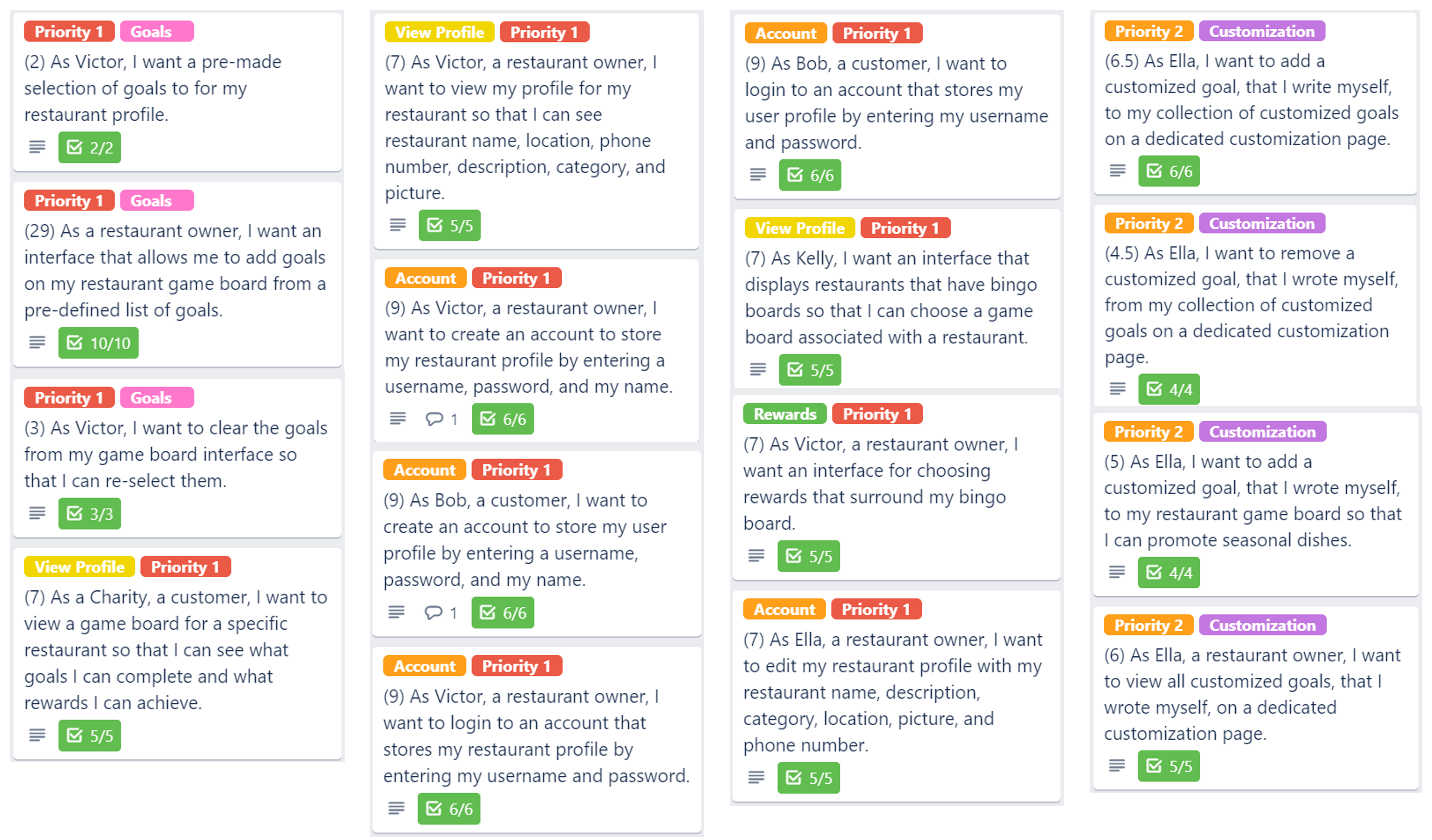
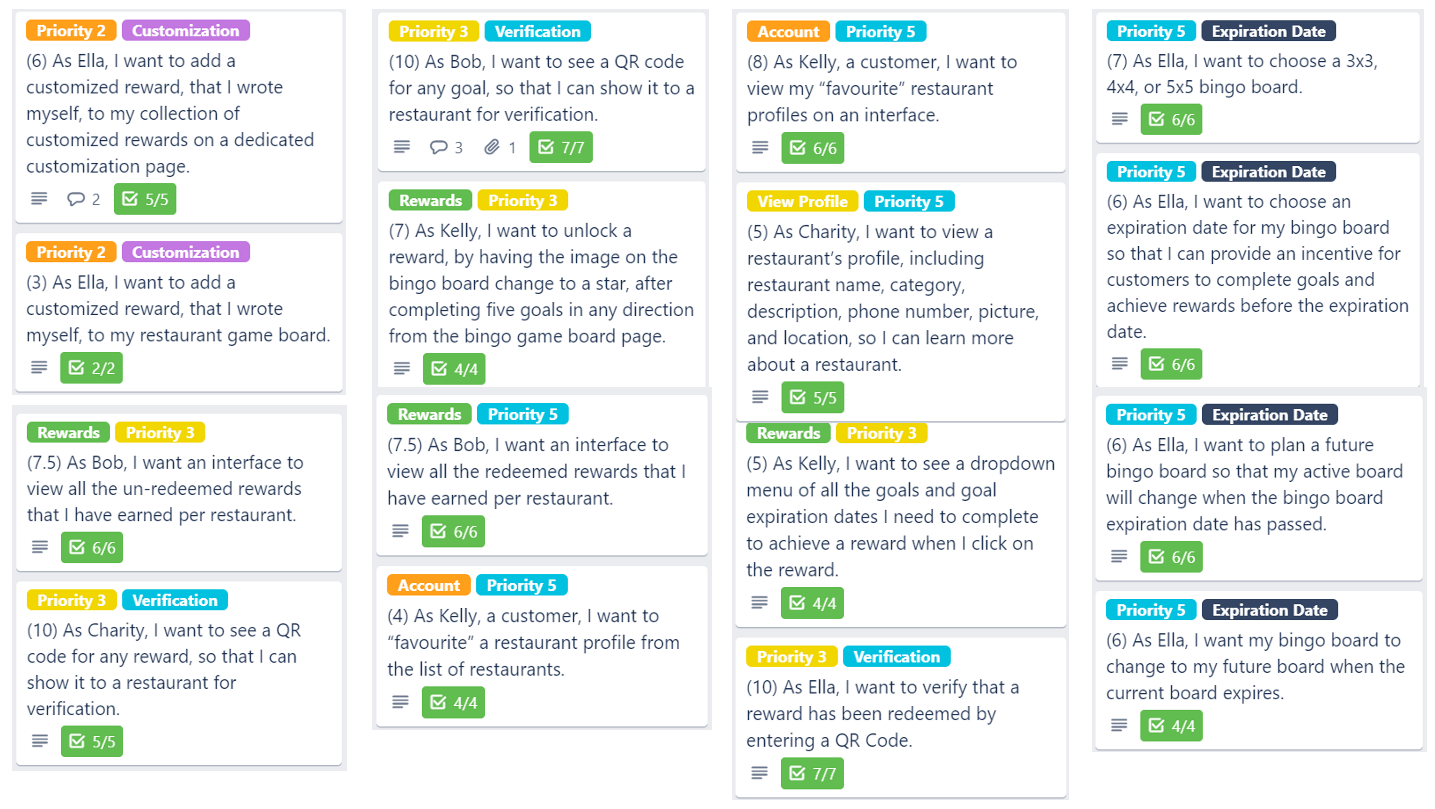

Three sprints were completed and are described in detail below.
Sprint 5: Backlog
- Priorities are labelled at the top of each card.
- Groupings of user stories are shown through the labels.
- Story points are shown in brackets in the user story titles.
- 1 story point = 2 hours
The full sprint backlog is as follows or as a pdf here:

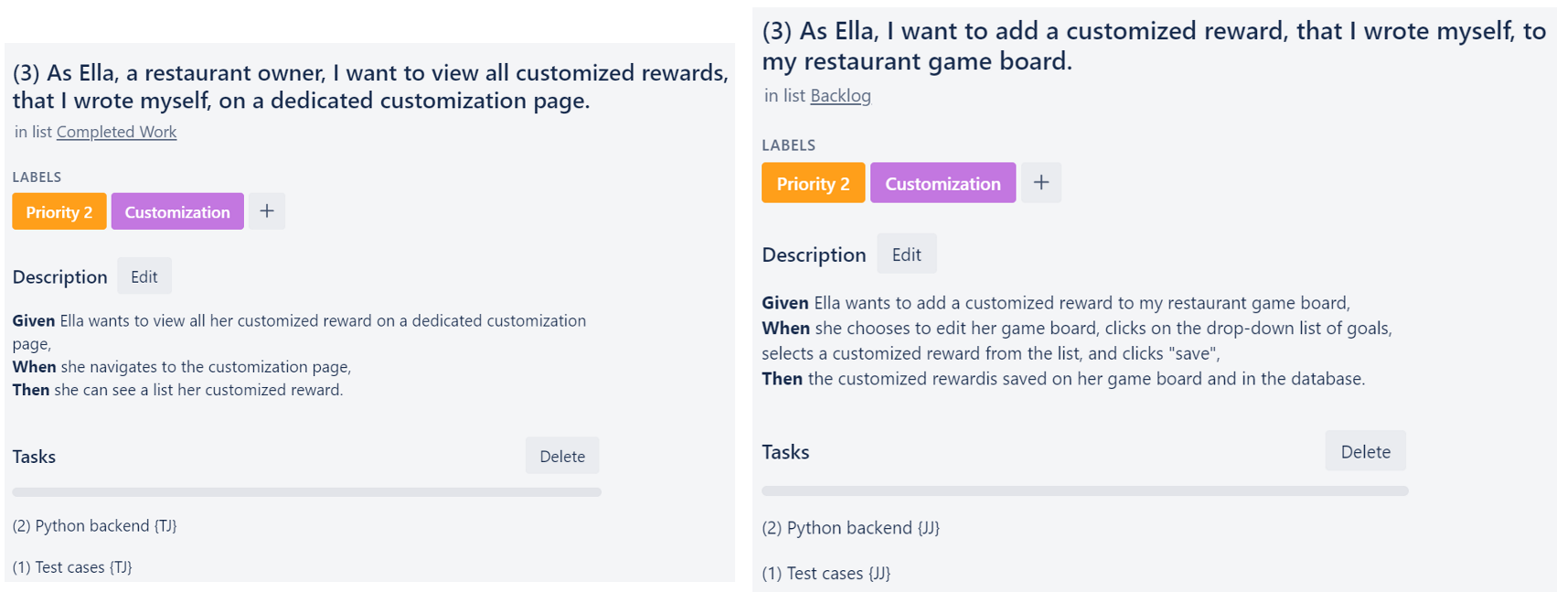
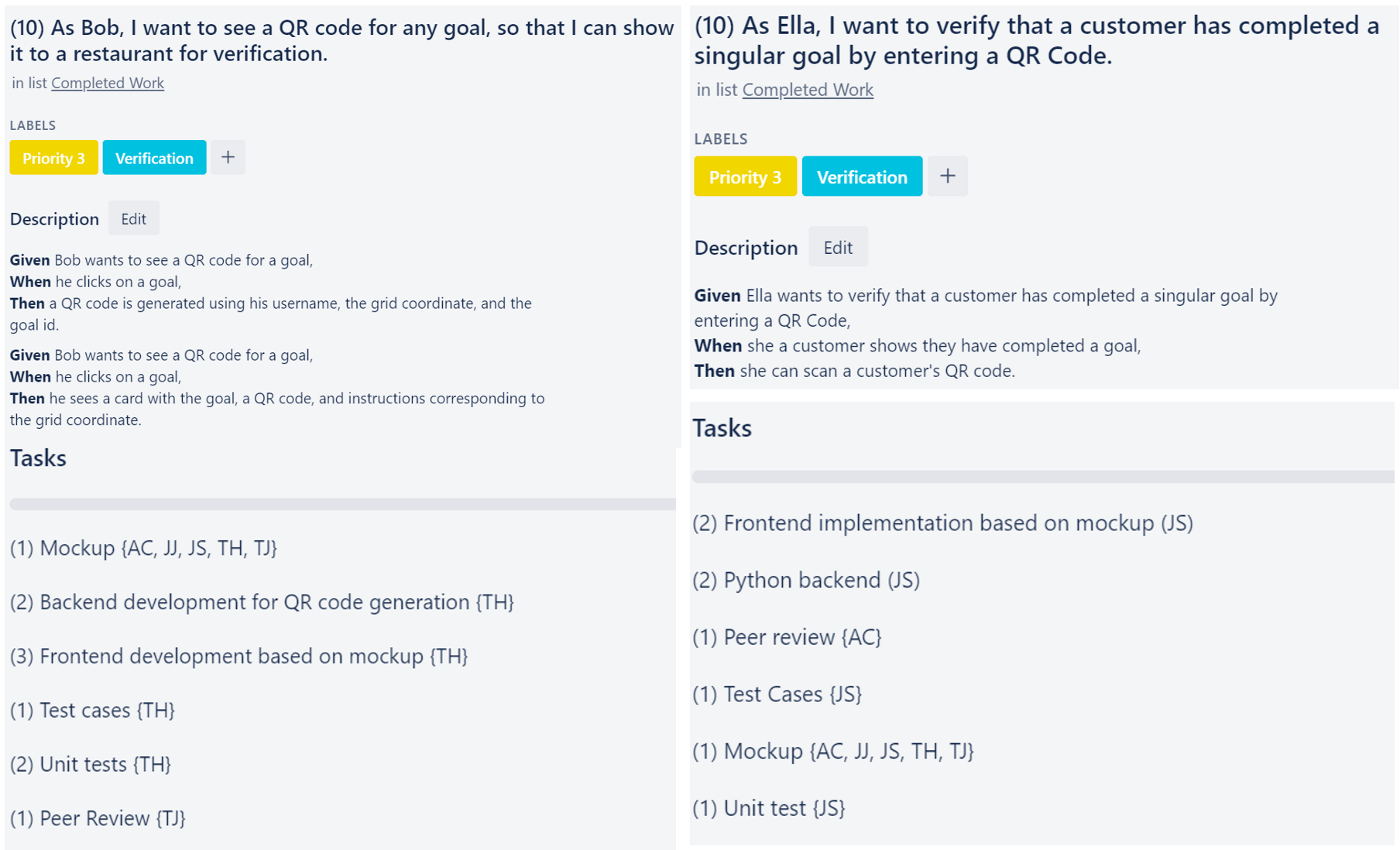 Sprint 5: Intitial
Sprint 5: Intitial
The following images contain the initial task board, division of tasks, and burndown chart for sprint 5, respectively.

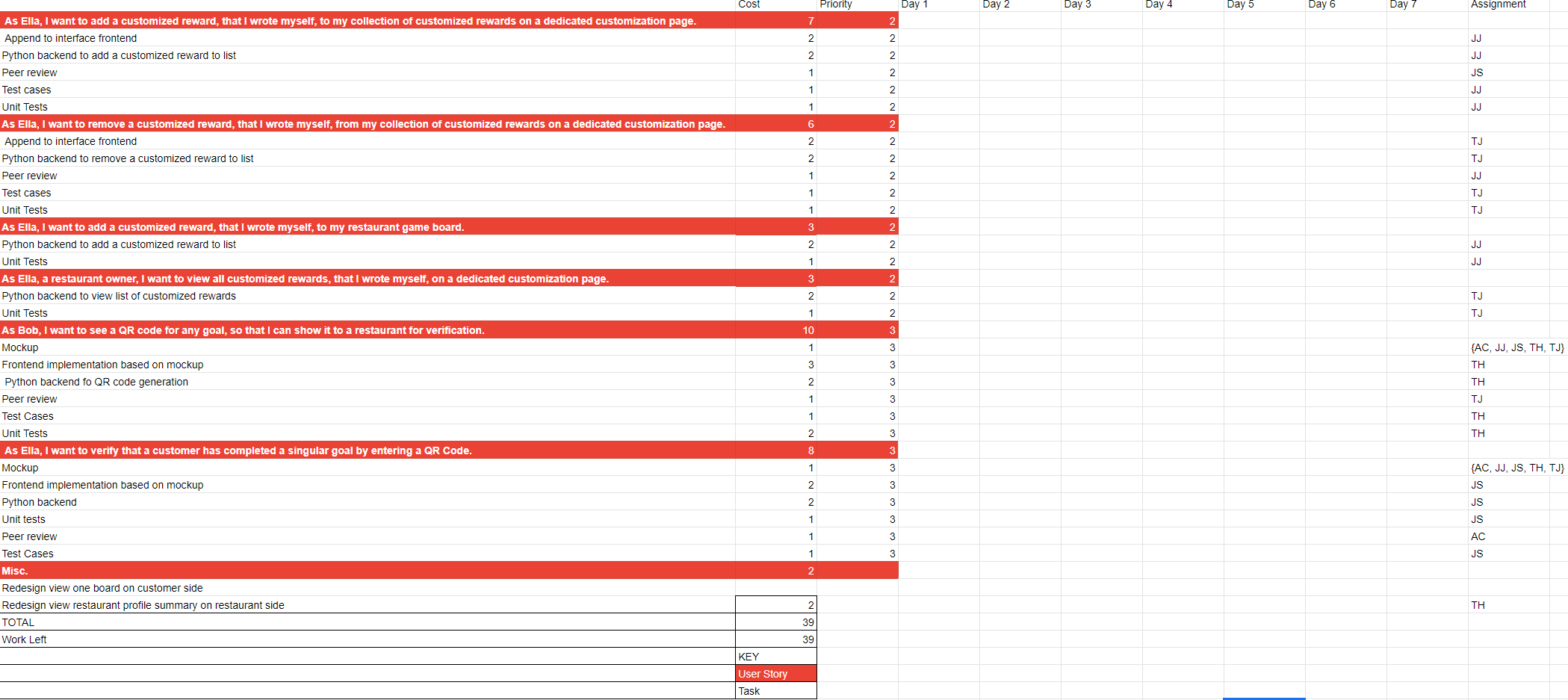
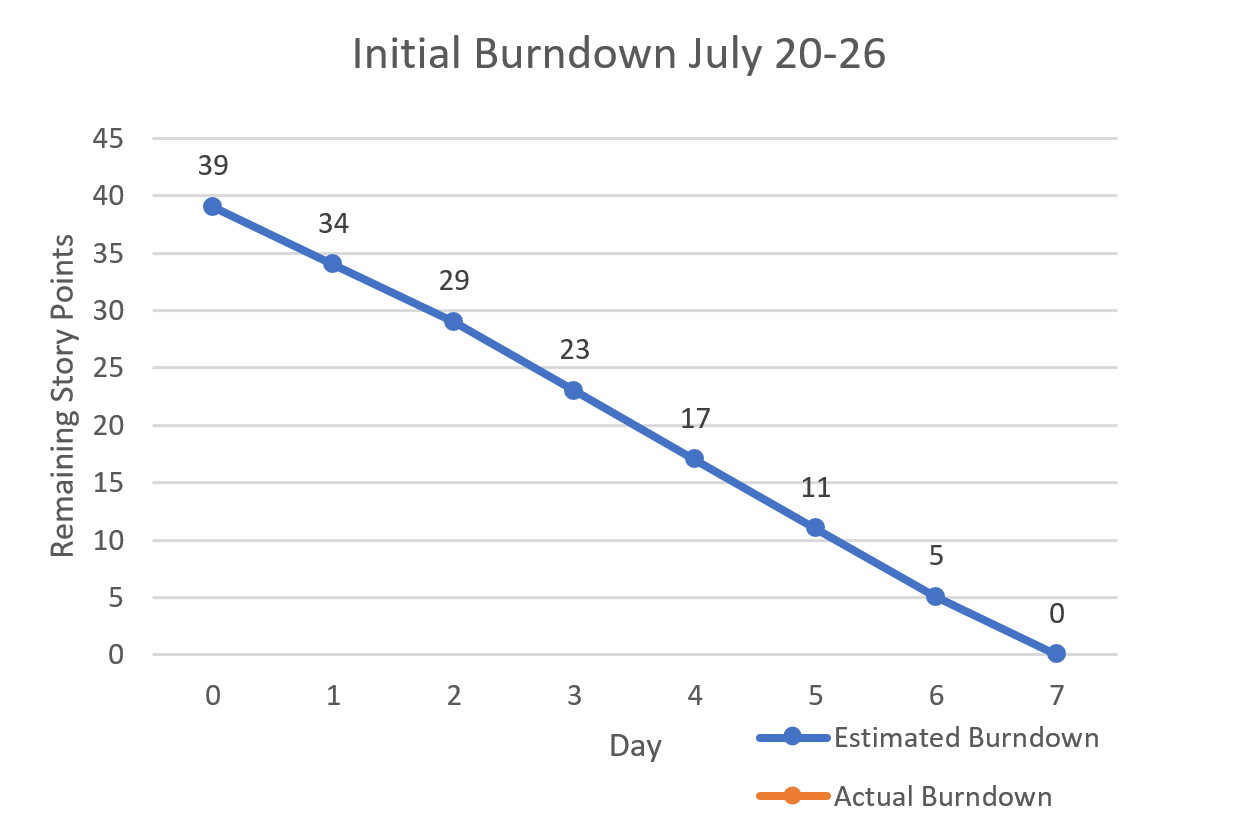
Sprint 5: Final
The following images contain the final task board, division of tasks, and burndown chart for sprint 5, respectively.
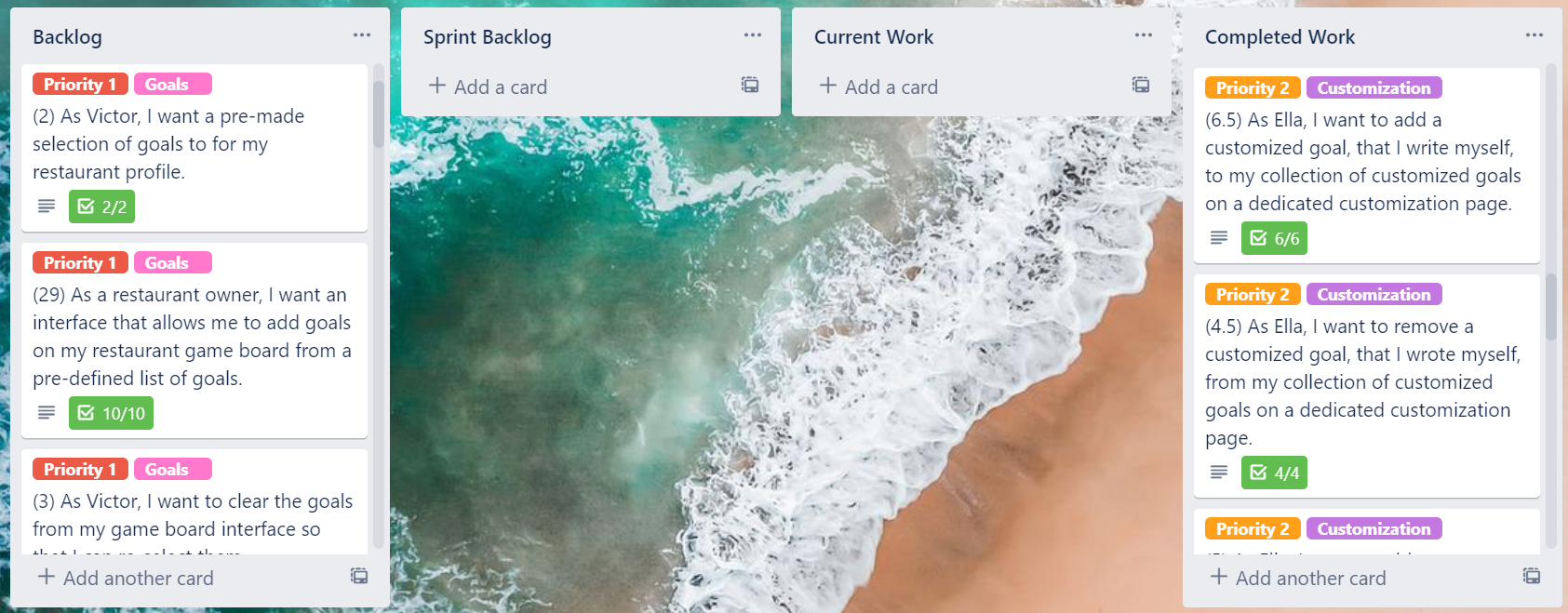
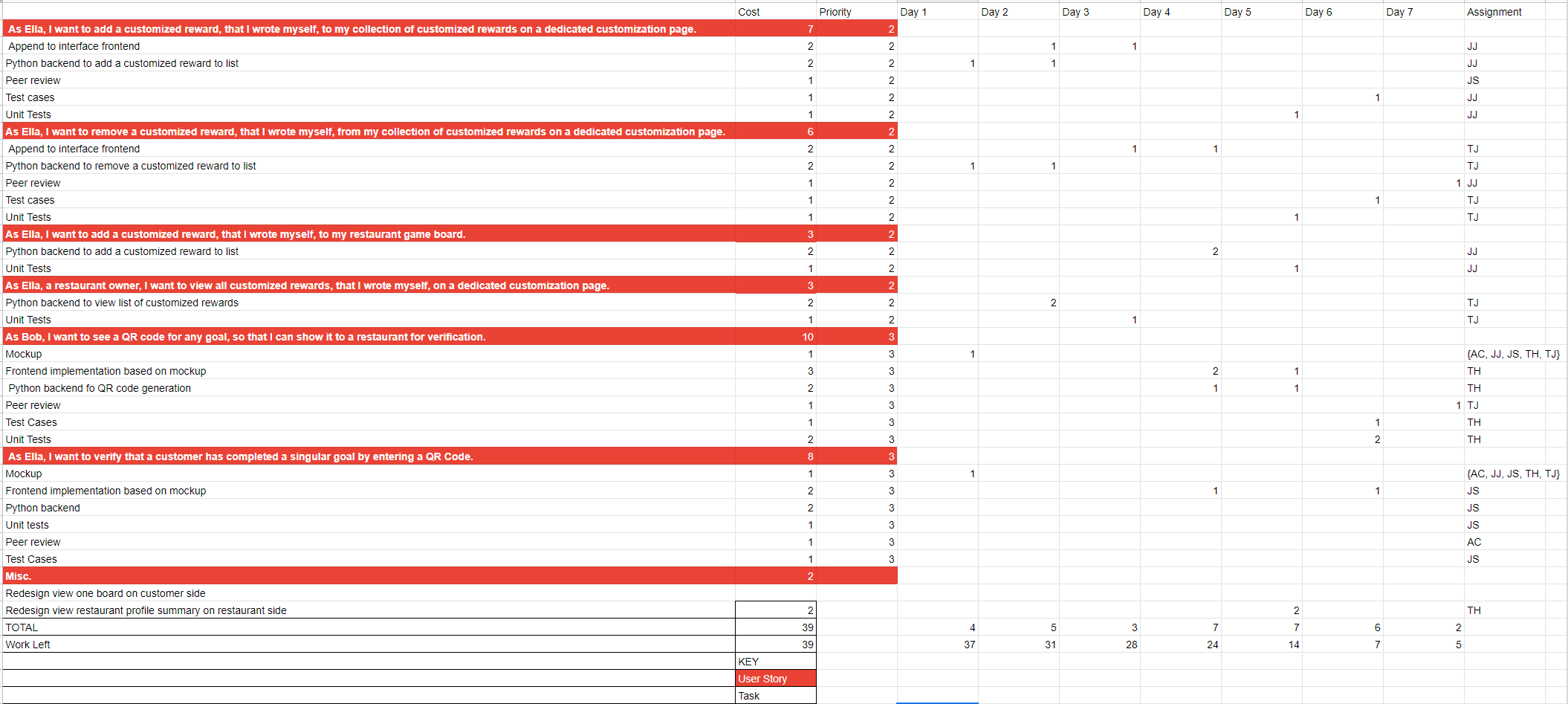
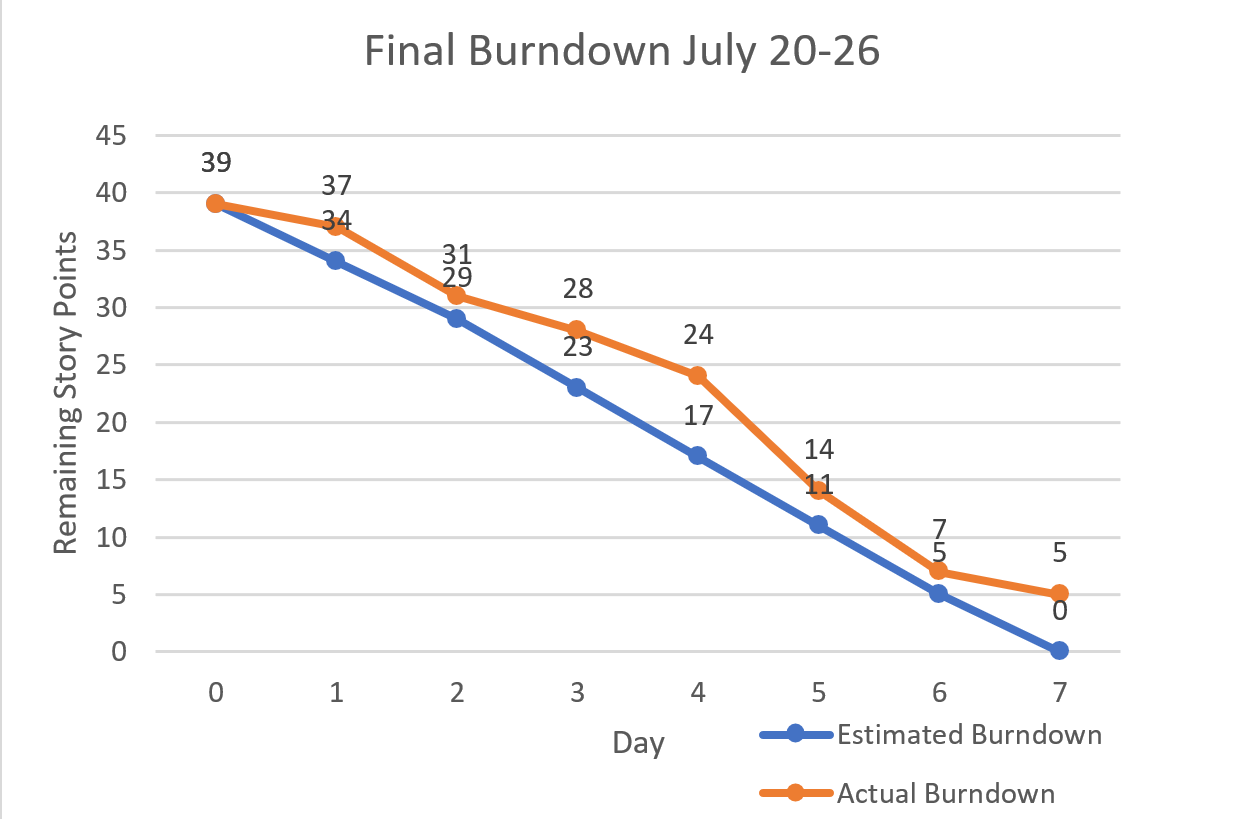
Sprint 6: Backlog
- Priorities are labelled at the top of each card.
- Groupings of user stories are shown through the labels.
- Story points are shown in brackets in the user story titles.
- 1 story point = 2 hours
The full sprint backlog is as follows or as a pdf here:
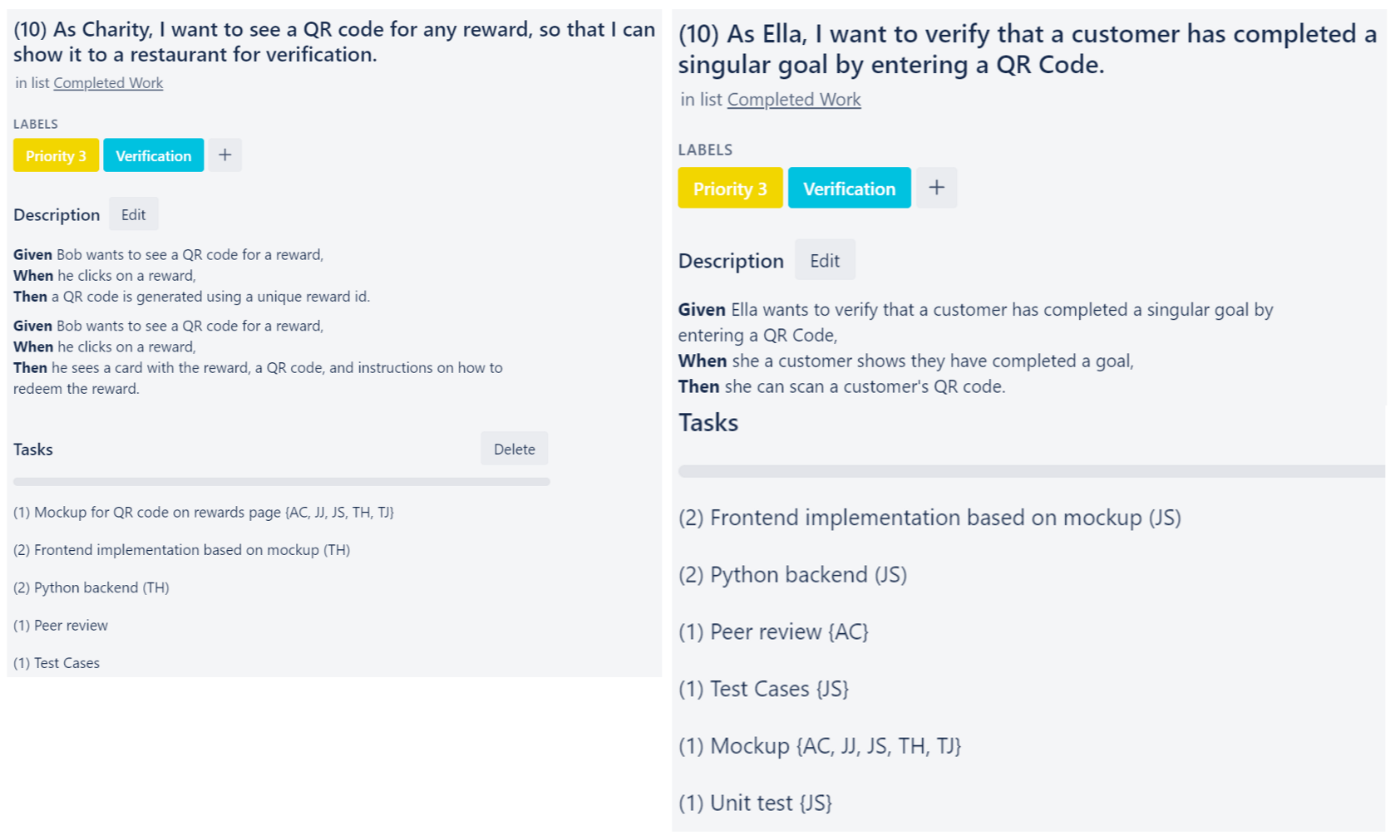
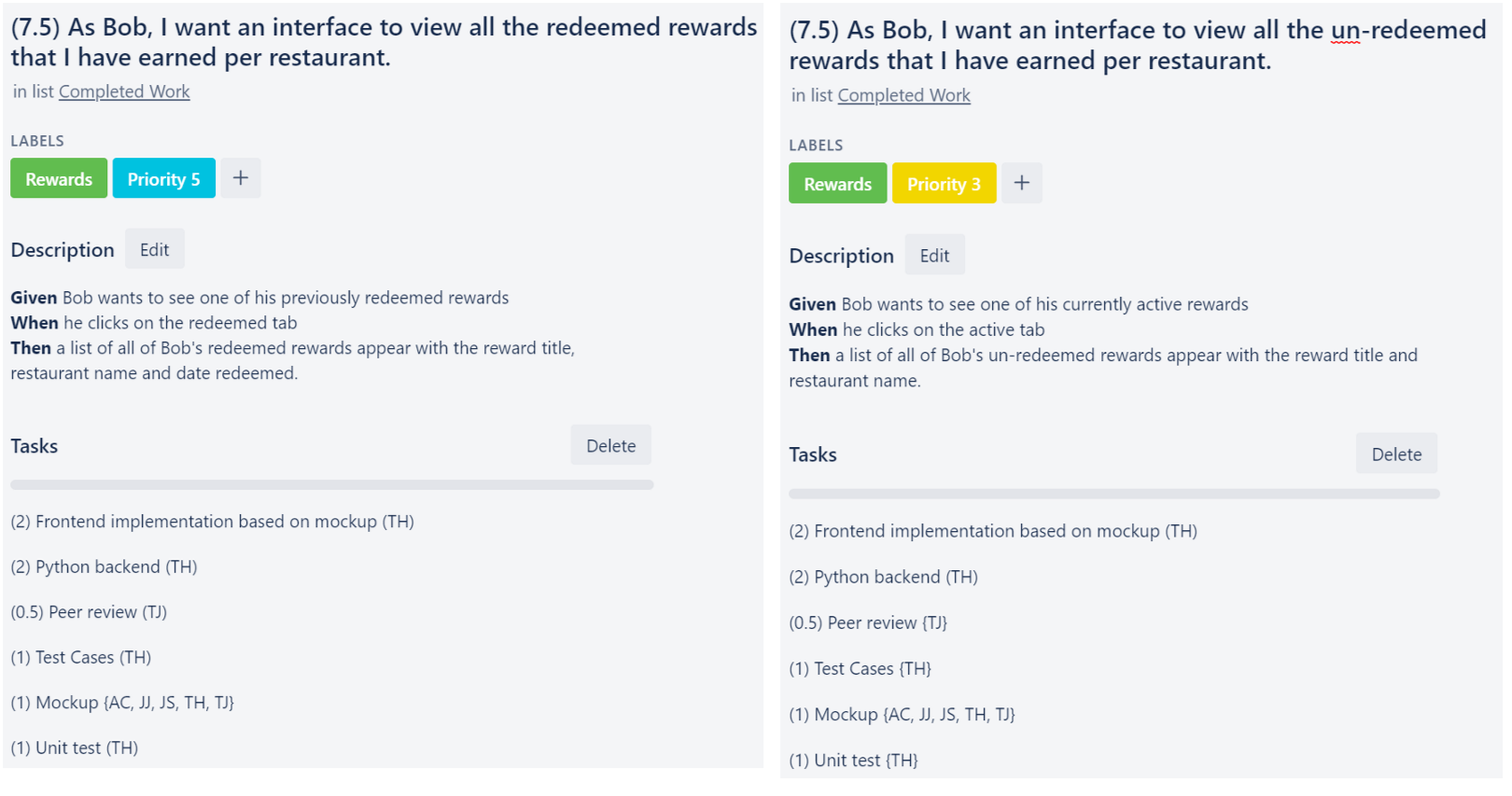
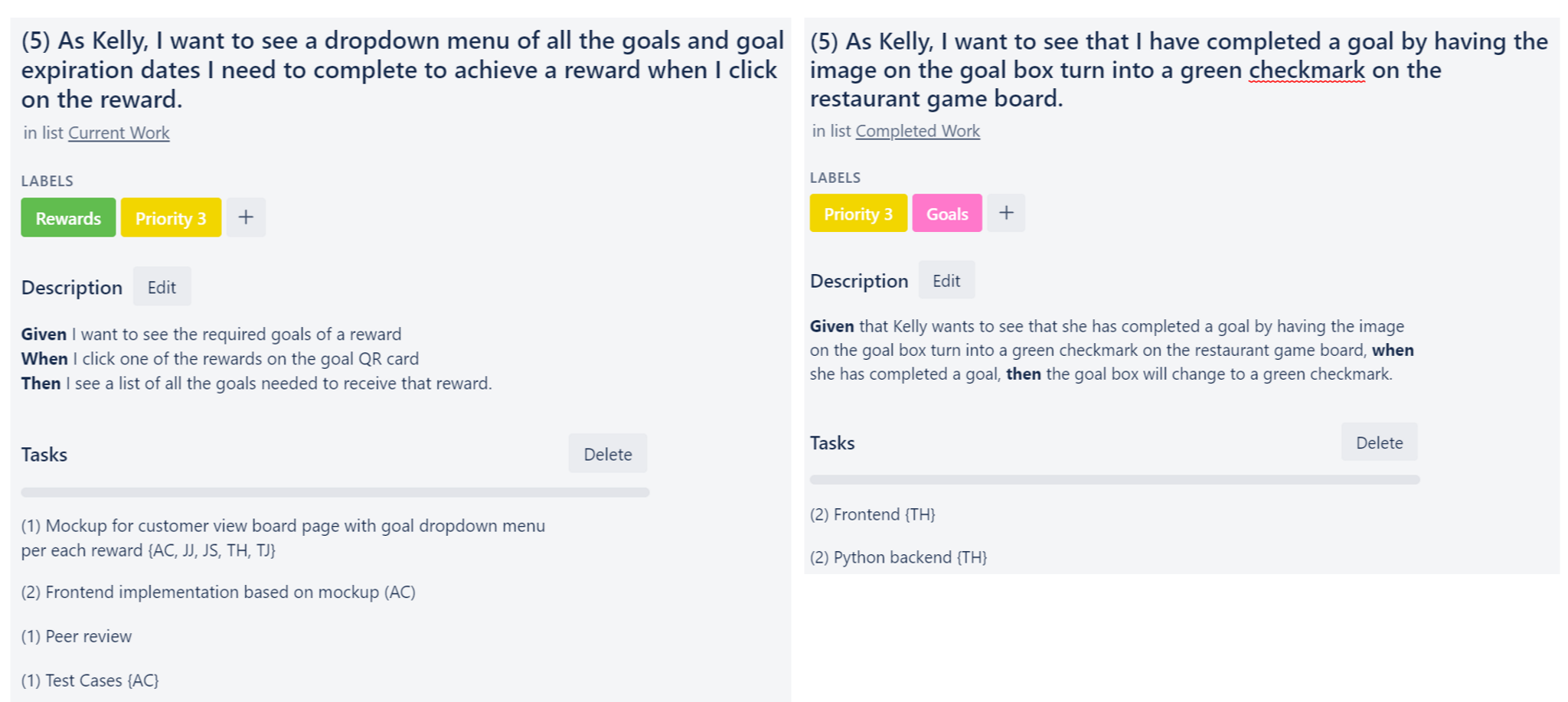
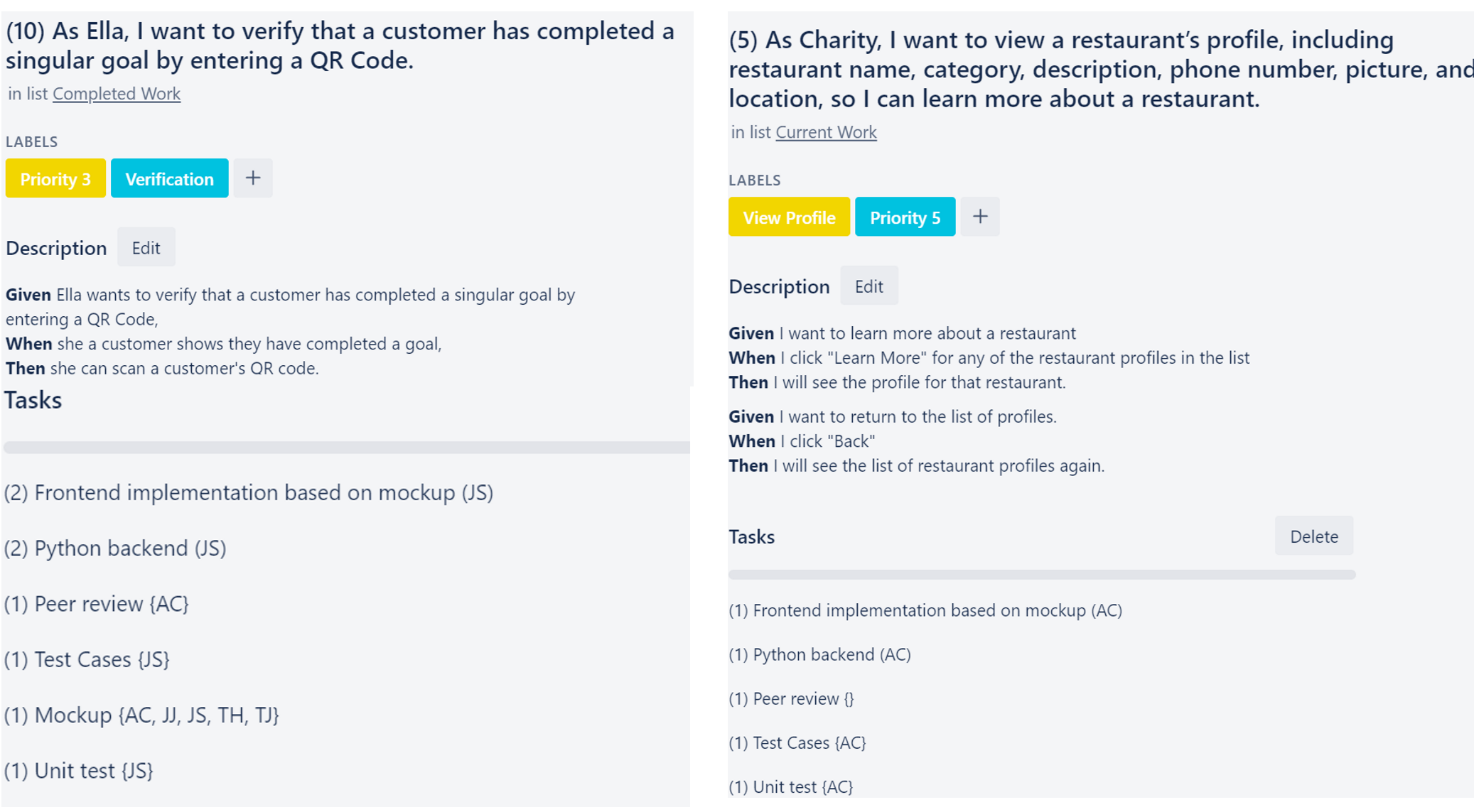
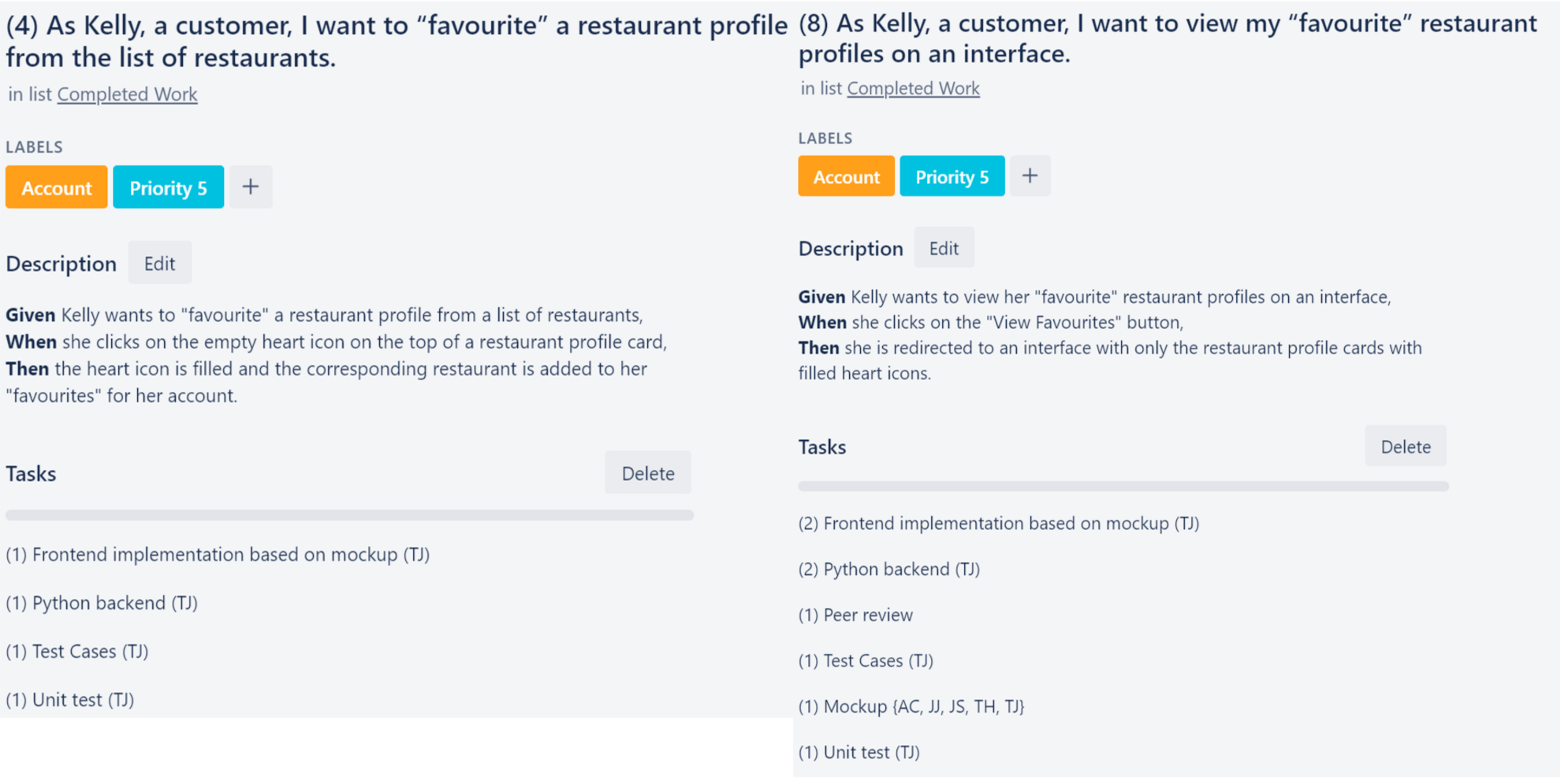 Sprint 6: Intitial
Sprint 6: Intitial
The following images contain the initial task board, division of tasks, and burndown chart for sprint 6, respectively.
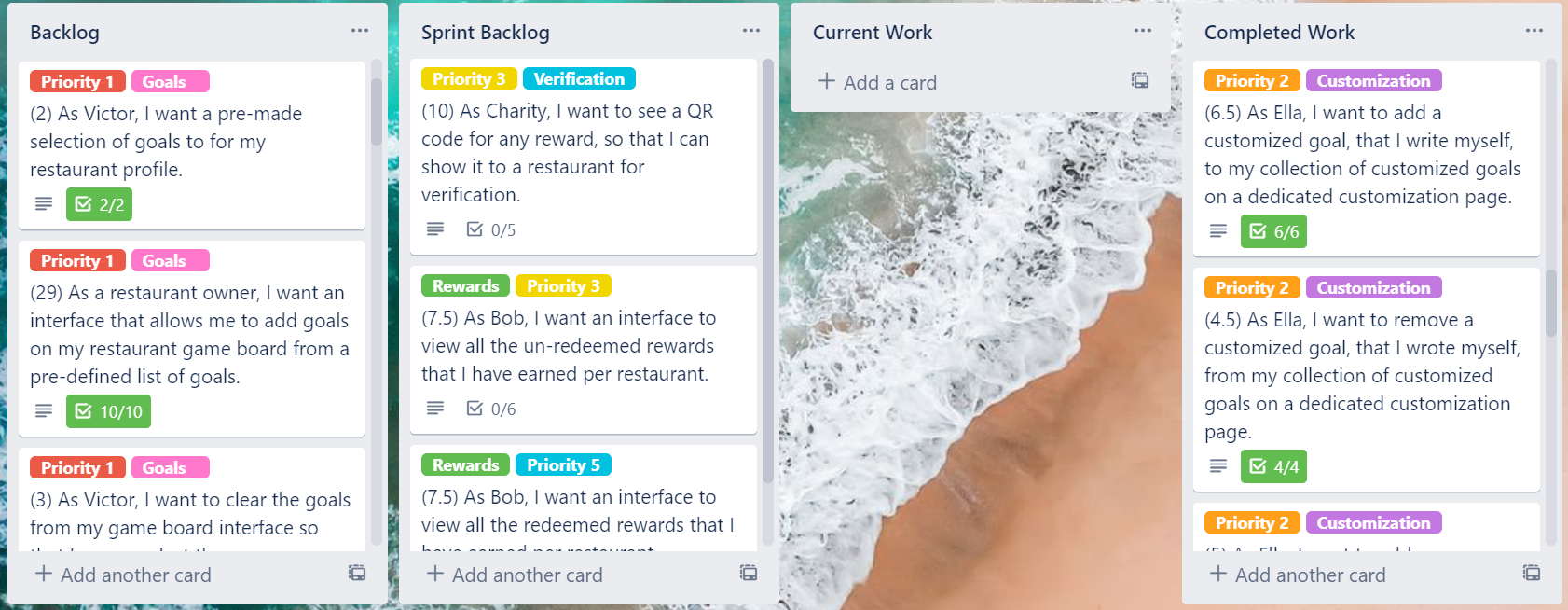
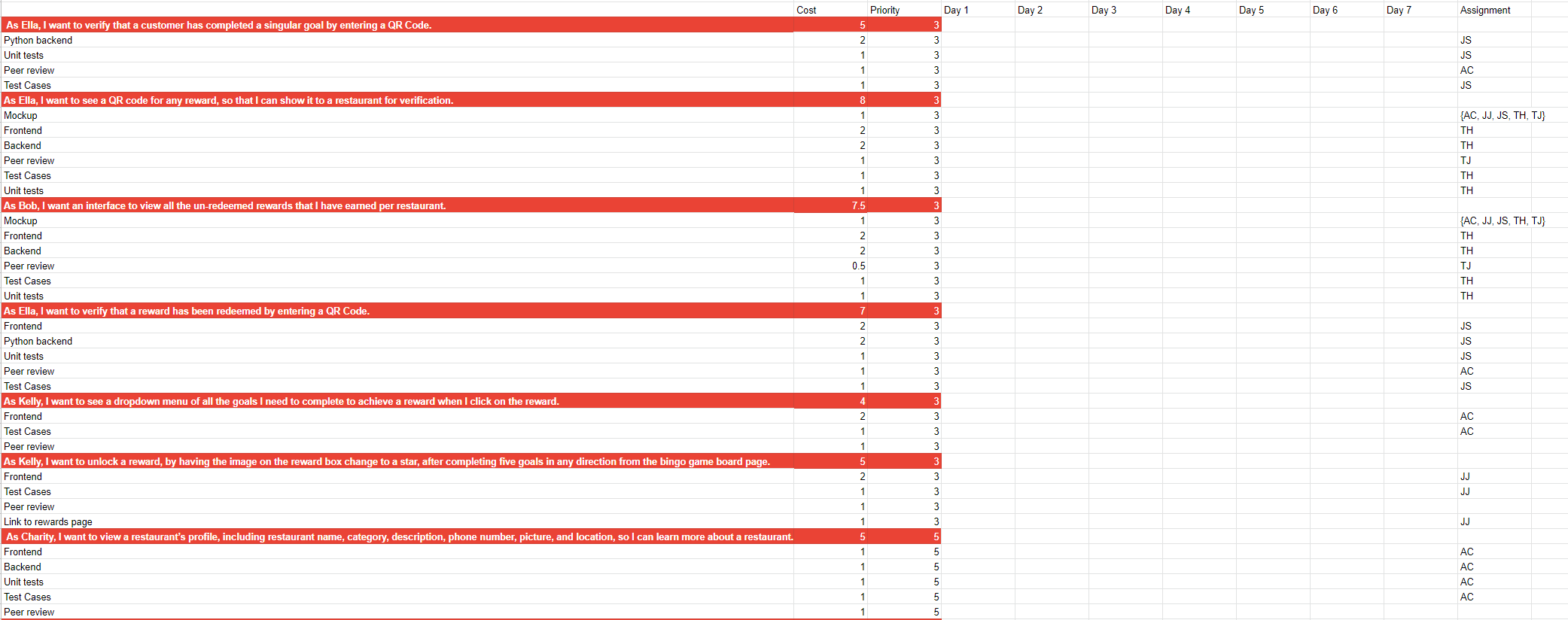

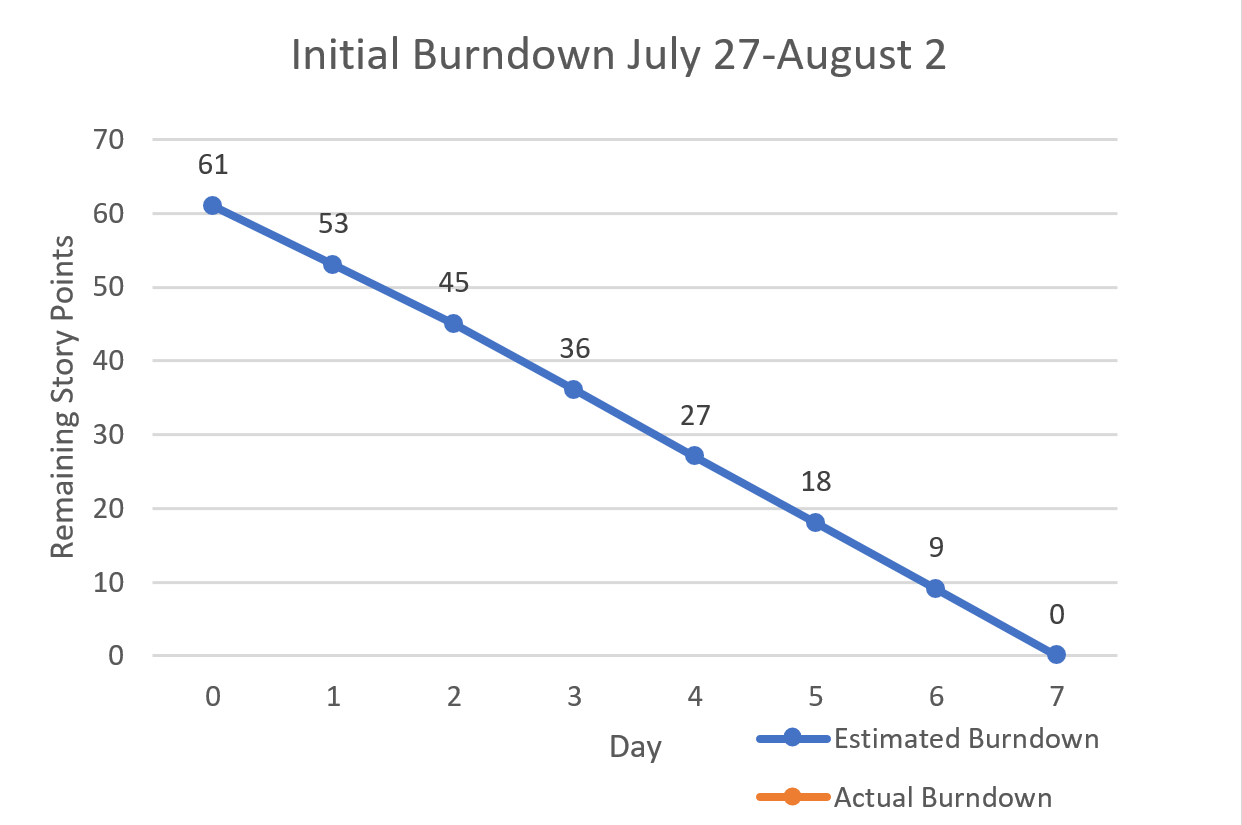
Sprint 6: Final
The following images contain the final task board, division of tasks, and burndown chart for sprint 6, respectively.
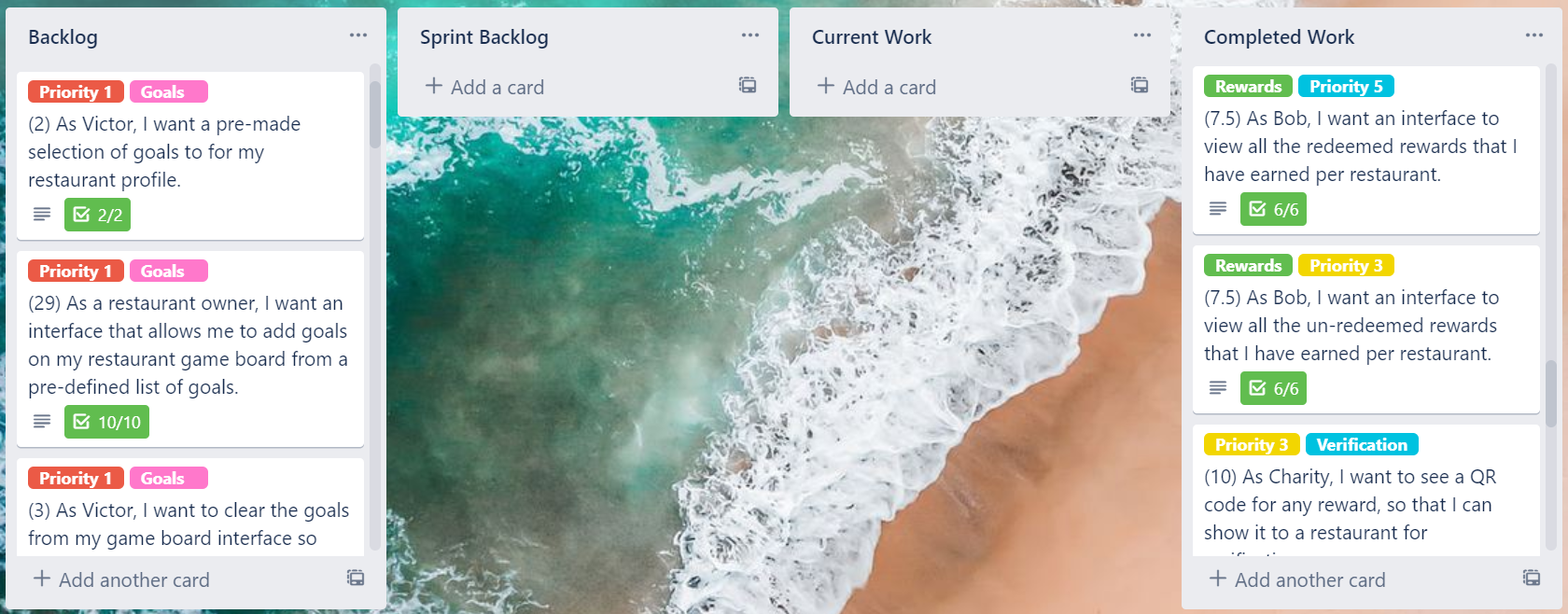
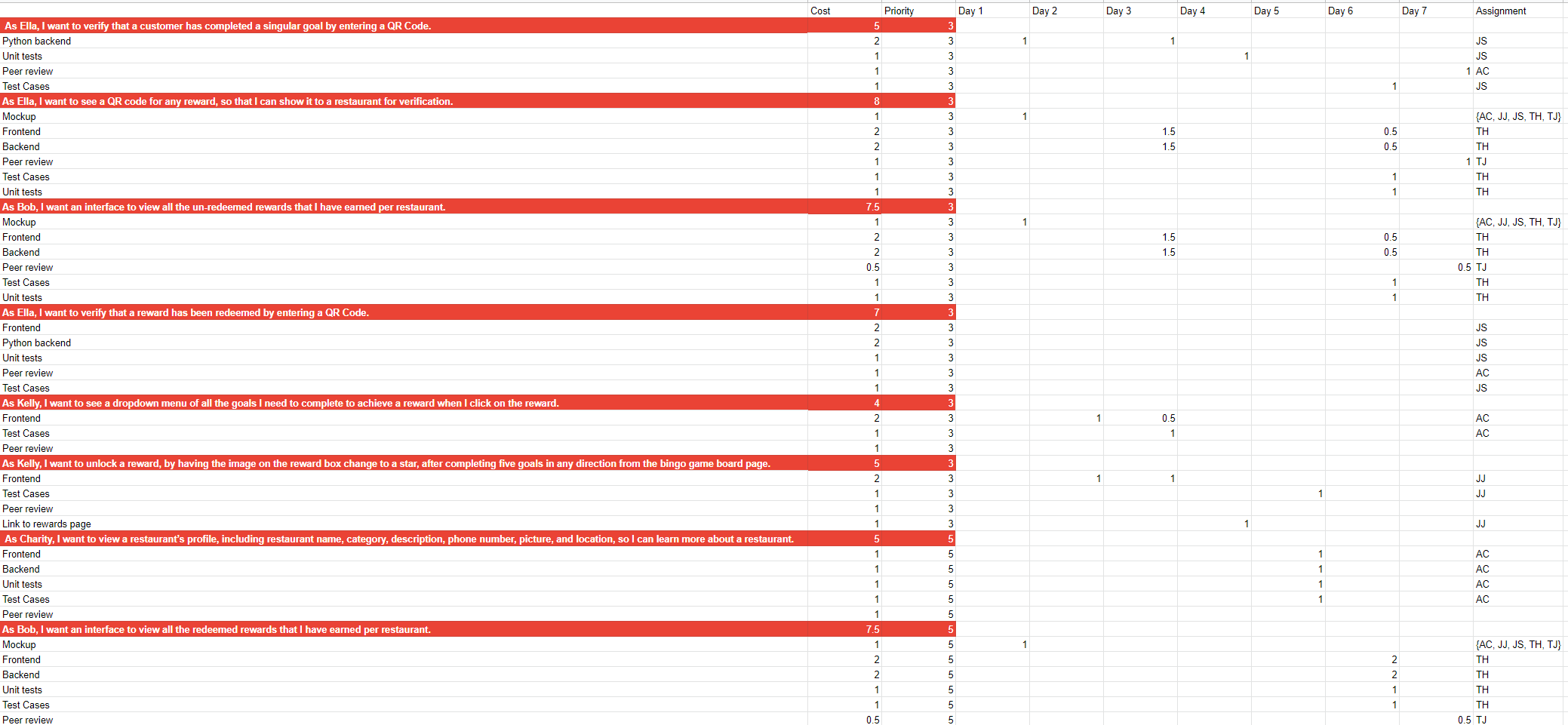

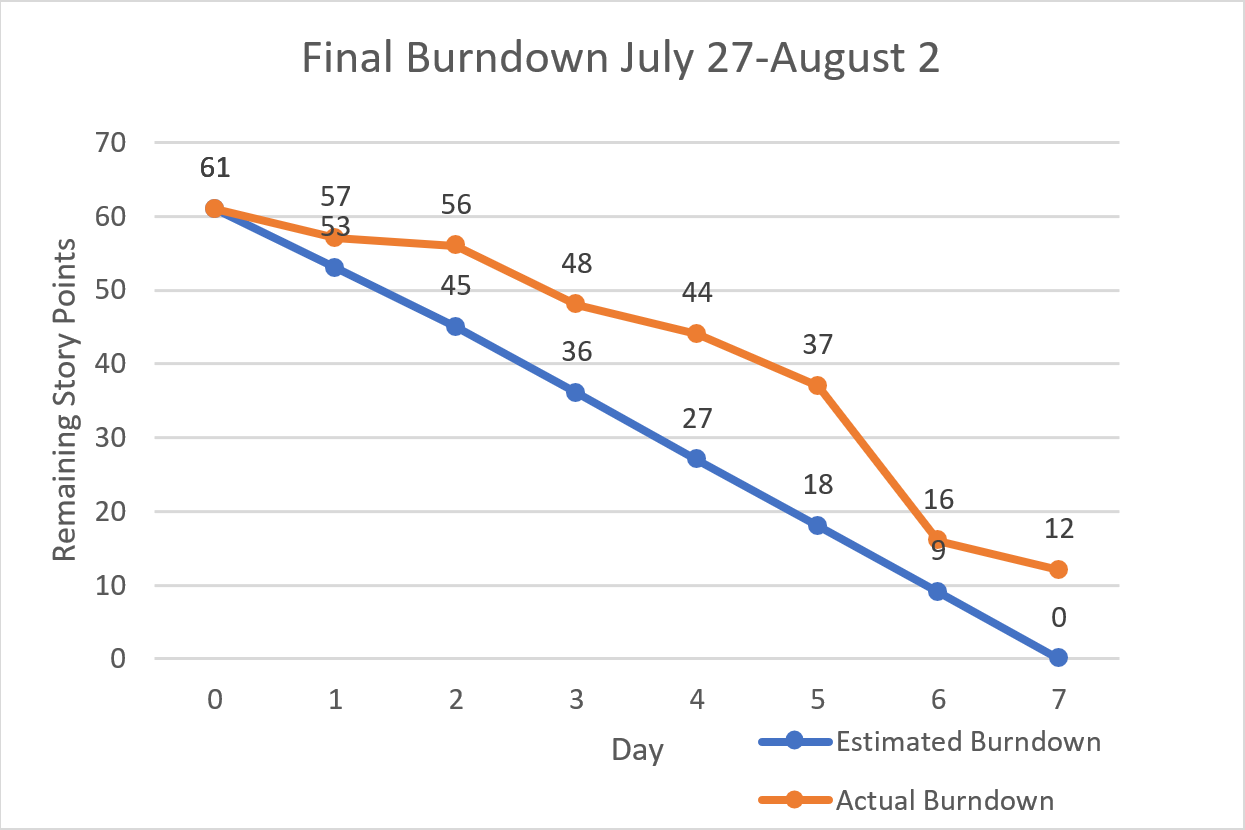
Sprint 7: Backlog
- Priorities are labelled at the top of each card.
- Groupings of user stories are shown through the labels.
- Story points are shown in brackets in the user story titles.
- 1 story point = 2 hours
The full sprint backlog is as follows or as a pdf here:
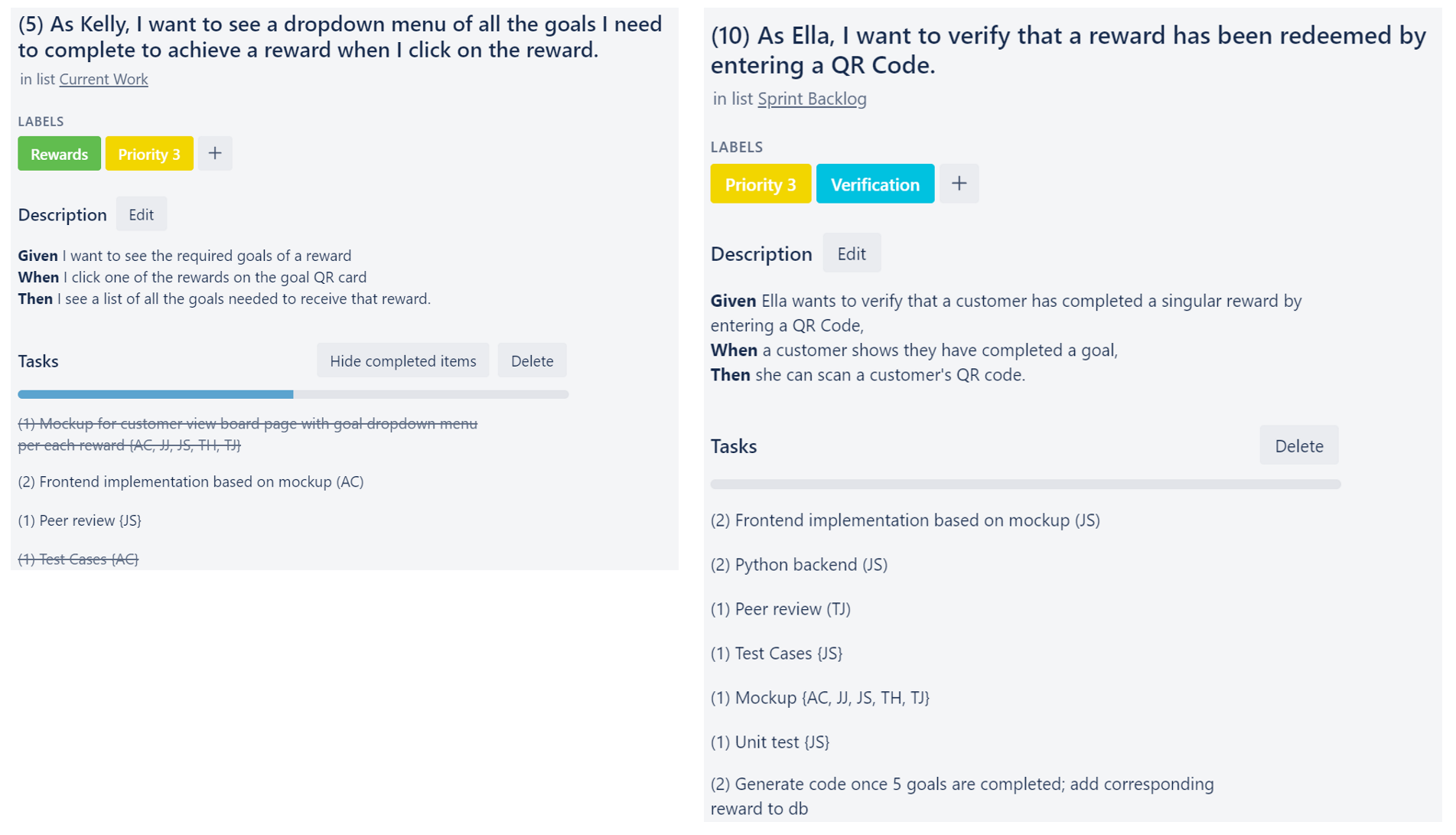
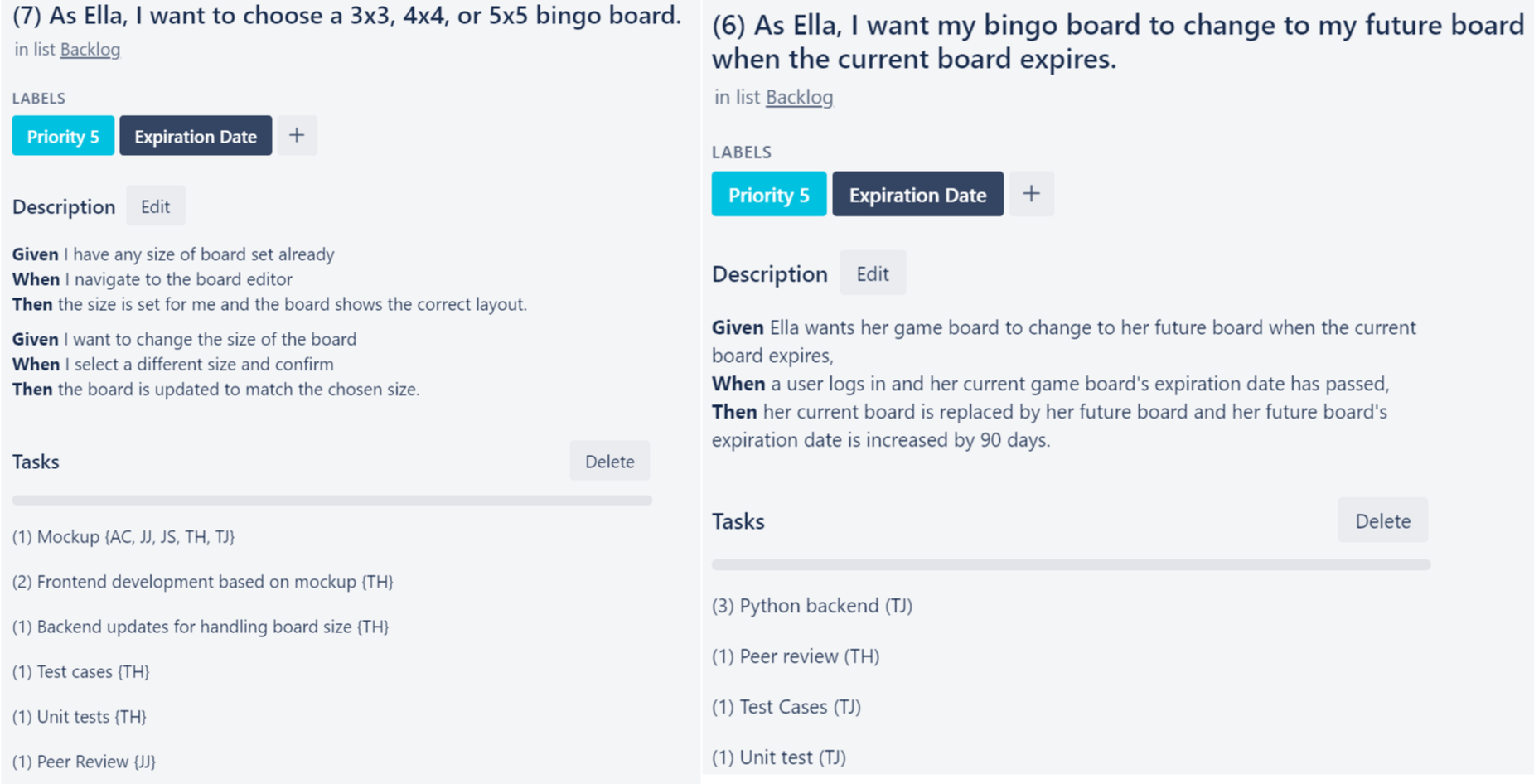
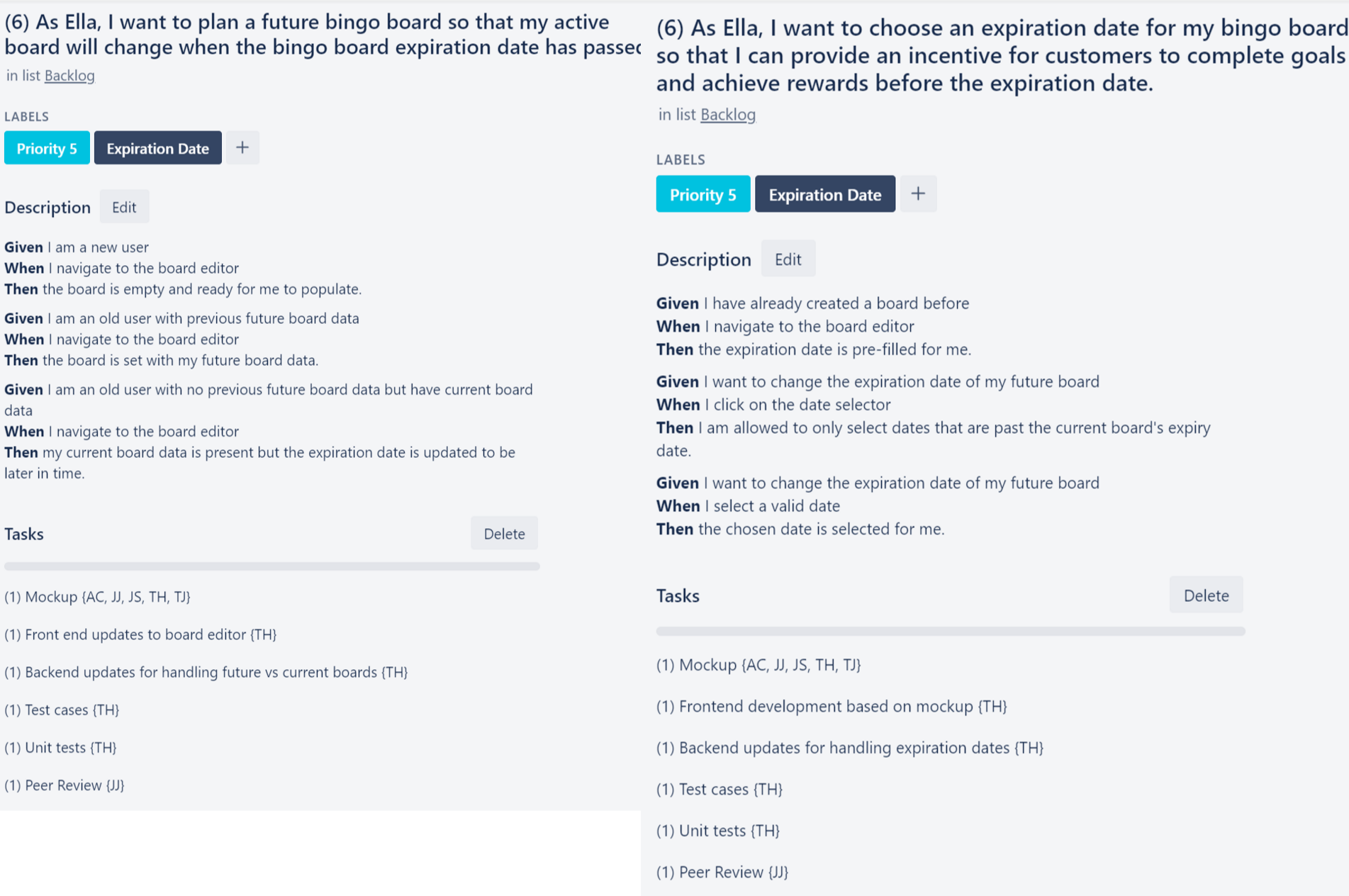
The following images contain the initial task board, division of tasks, and burndown chart for sprint 7, respectively.
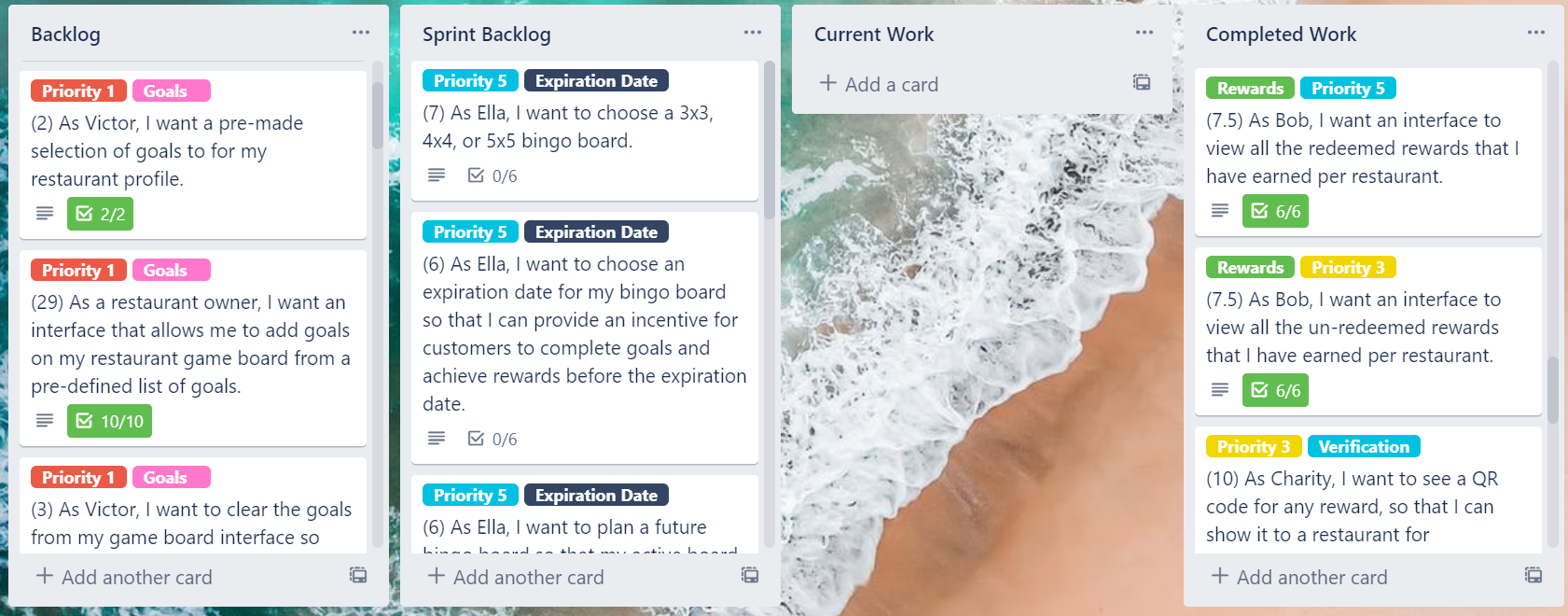
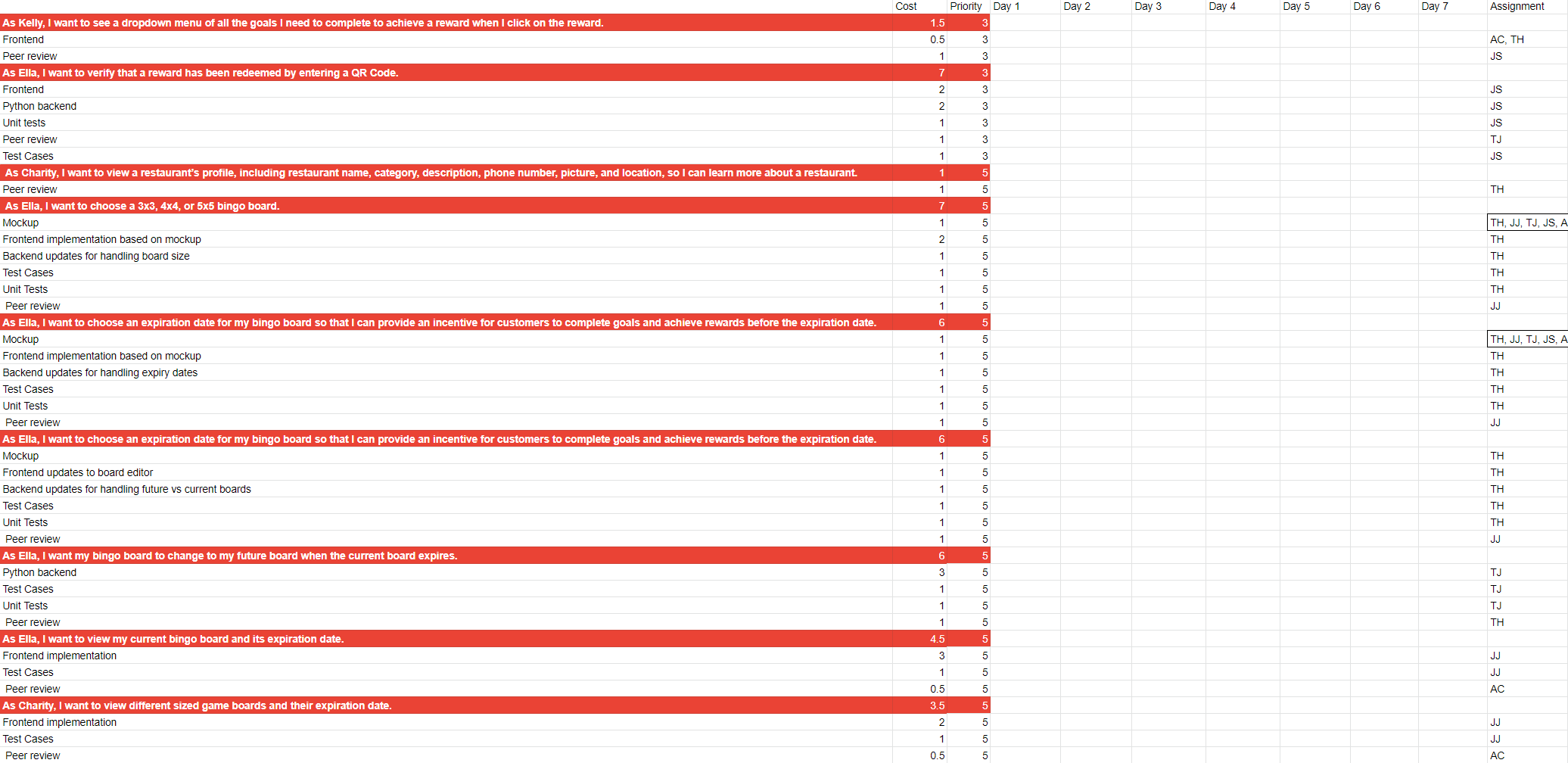

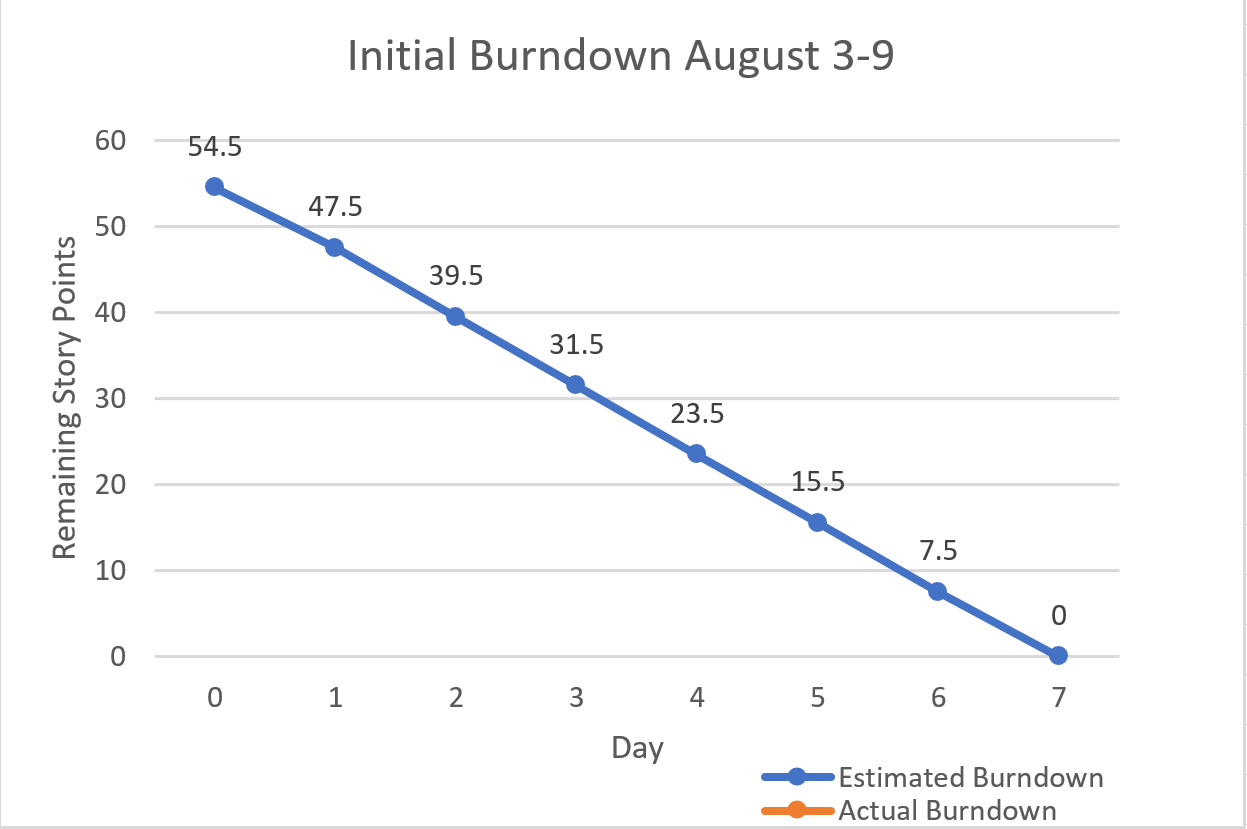
Sprint 7: Middle
The following images contain the final task board, division of tasks, and burndown chart for sprint 7, respectively.
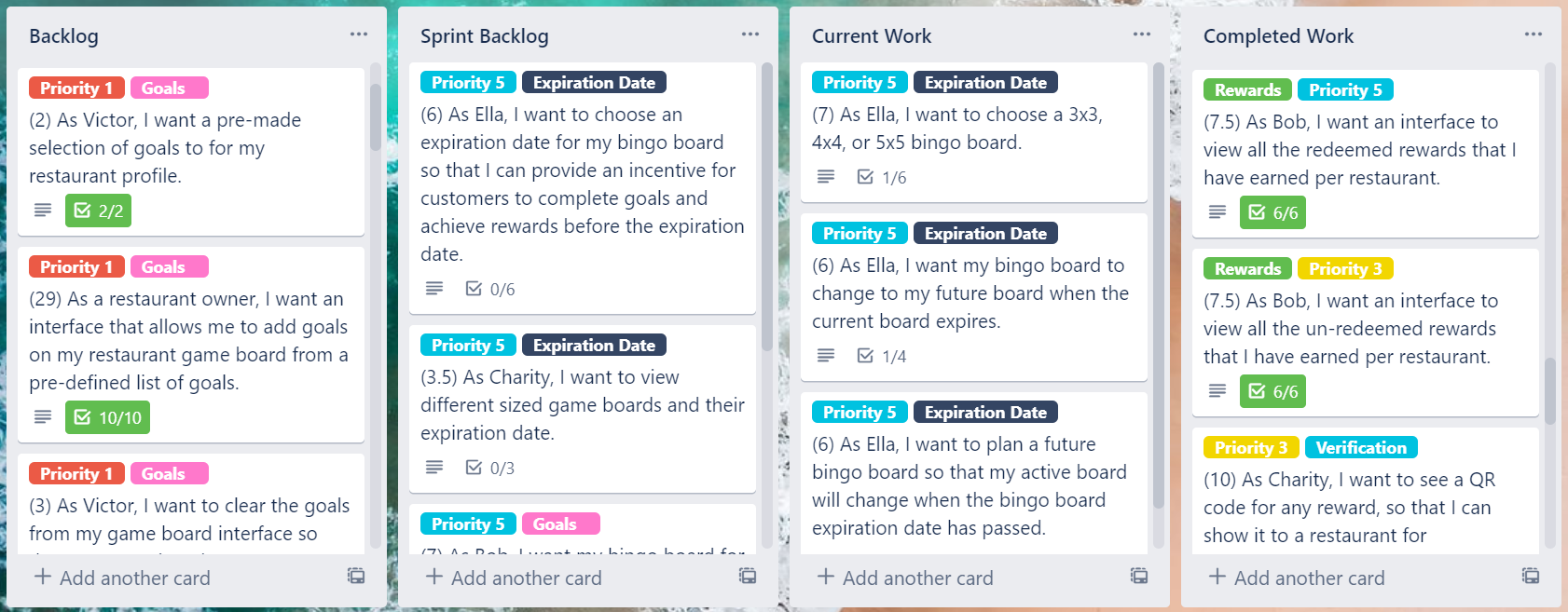
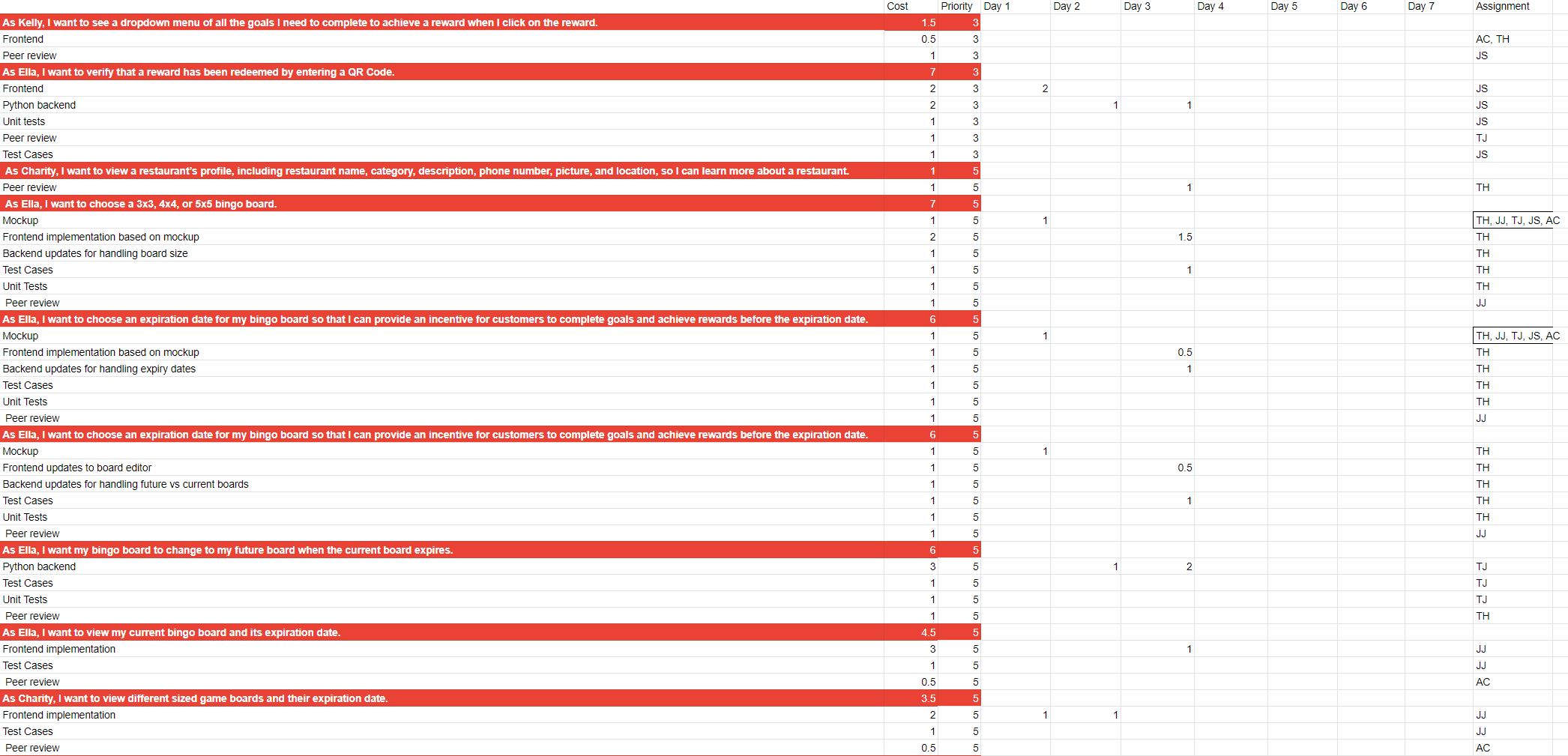

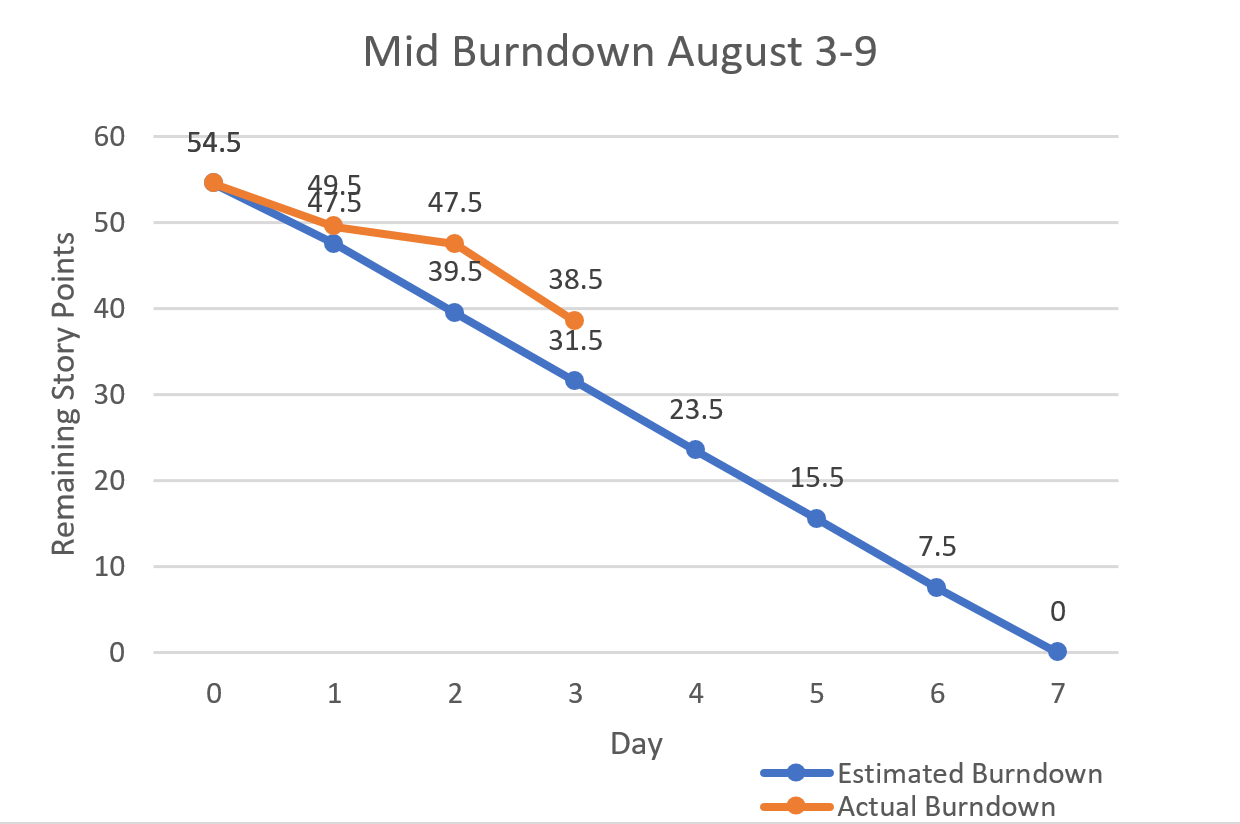
Sprint 7: Final
The following images contain the final task board, division of tasks, and burndown chart for sprint 7, respectively.
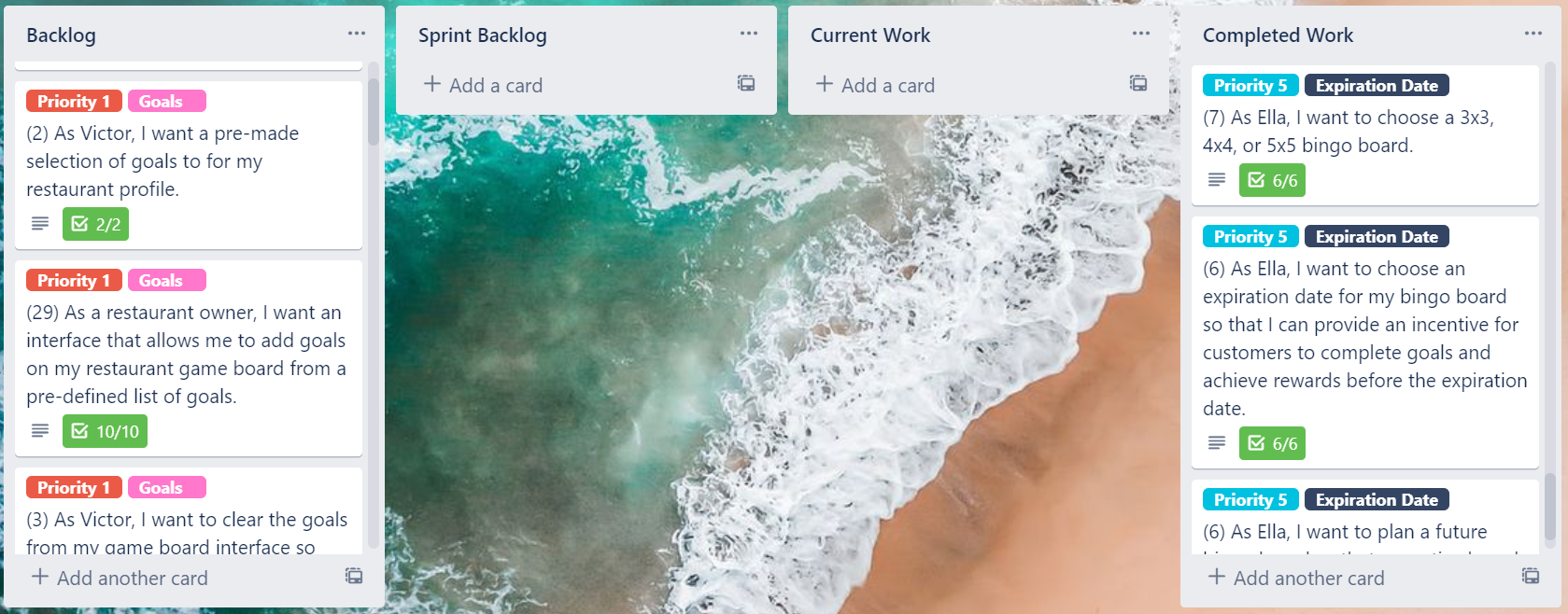
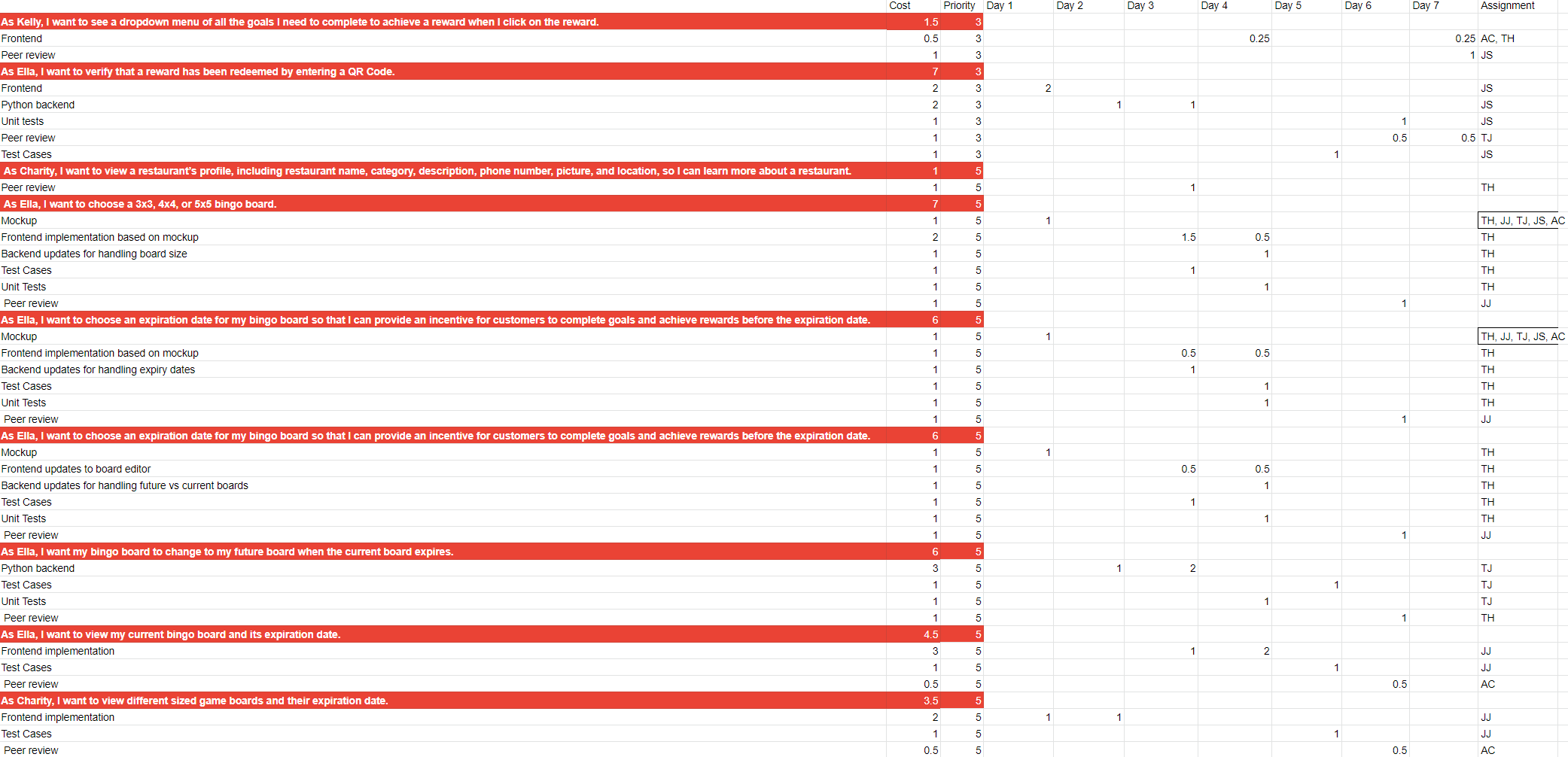

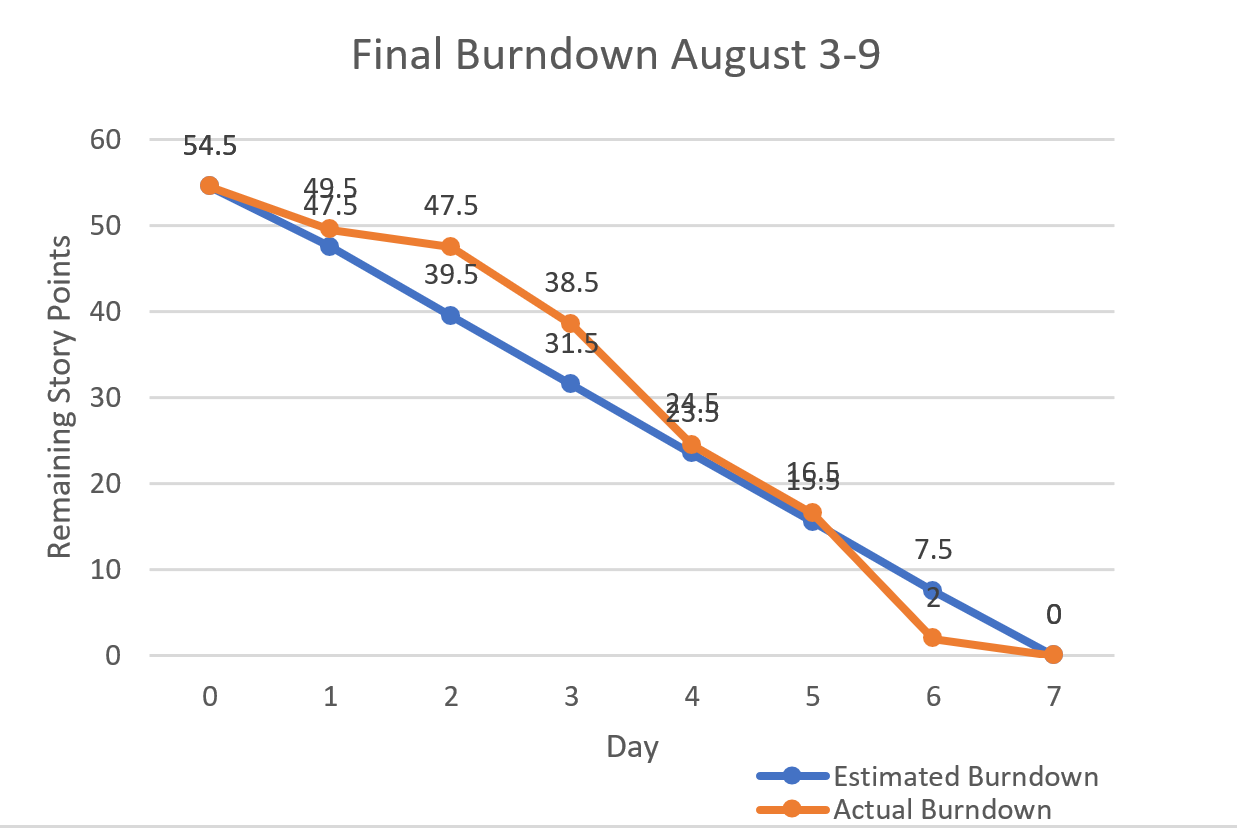
- Sprint 5: 39 story points
- Sprint 6: 61 story points
- Sprint 7: 54.5 story points
Our estimated project velocity increased as some story points were carried over. Also, as a part of our initial planning for sprint 6, we decided to assign more than usual with the intention of carrying over whatever was left into sprint 7, since sprint 7 would be our final sprint.
Actual Project Velocities- Sprint 5: 34 story points
We were unable to complete all tasks for this sprint as school had become very busy for most of us, and for some, it was still midterm season. The remaining story points were carried over to the next sprint. - Sprint 6: 49 story points
The reason we were unable to complete some of the tasks is similar to the reason for the last sprint. The carry over of story points from the previous sprint and the larger estimated project velocity also contributed to the difference between estimated and actual. - Sprint 7: 54.5 story points
Majority of these points were what was left from the previous sprint. However, as we were merging our final project we realized there were some tasks needed to be completed in order to make our project more cohesive and presentable.
For the first sprint of this deliverable, sprint 5, we were mostly able to follow our plans, since our estimated project velocity was relatively low; some story points carried over, but no replanning was necessary. Our planning for sprint 6 was not followed exactly, but this could be due to the fact that our plans for sprint 6 included sprint 7. Again, points needed to be carried over without any replanning.
One thing we did need to replan was how to deal with the expiration dates of bingo boards, goals and rewards. After receiving our client’s feedback, we held a quick meeting discussing how we would solve the issue. Thus, we replanned accordingly.
For the whole of our project, we have mostly managed to follow our plans almost exactly. As was mentioned in our previous deliverable reports, we have overcome the times where our plans were not met exactly. However, some features we planned initially were not able to make it into our final release as we had run out of time. These features were of a lower priority, which is why they were left to the later sprints. However, we deemed it more important to clean up bugs and our user interfaces in order to make our final product more professional. Thus, we may not have followed our plans exactly, but we were able to finish the majority of the features that we had planned initially.
A difficulty that we encountered occurred after our team discussed integrating the feature to allow restaurant owners to choose individual expiry dates for goals and rewards on their bingo board. This feature was suggested by our client, as they did not think having an expiration date for a 5x5 board was a good idea, as customers may not be able to complete 25 goals before the expiration date. While discussing the implementation of this feature we discovered many problems with it. Some of these problems included what would happen to the completion status of a completed goal if it were to expire and how a restaurant can feasibly maintain the expiry dates of 25 goals and 12 rewards.
We came up with the idea that a restaurant owner could choose a smaller 3x3 board with an expiry date for the entire board, and brought up this idea with the client. They agreed this was a good solution, and thus our difficulty was resolved.
We did not have to use our contingency plan for the past 3 sprints; no team members dropped out, were sick, consistently missed meetings, or were academically dishonest. As a result of this, we did not have to use our contingency plan or come up with new solutions.
We tried to complete as much work as possible before the project deadline by assigning a higher number of story points for each sprint. As a result of the higher project velocity, some stories had to be pushed to following sprints. However, this did not affect our plan drastically, due to our just-in-time planning strategy for each sprint.
At the end of Deliverable 4, our team’s release included a lots of implemented functionality. Restaurant users and customers have dedicated interfaces to sign up to make an account and login. Restaurant users have a customizable profile, and can choose to create, view, and remove custom goals on a dedicated interface. They can edit and save changes to their bingo board with pre-defined and customized goals, as well as rewards from a pre-defined list. For customers, when they log in they can view a list of restaurants with visible profiles, and choose to view the full profile or the restaurant’s bingo board.
By the end of Deliverable 5, our team’s latest release includes improvement on our previous work, as well as many more implemented features. Restaurant users can now customize rewards on a dedicated interface, choose from 3 sizes of game boards, set an expiration date for their game board, and plan a future game board. When their current game board’s expiration date passes, it is replaced with their future board. They have an interface where they can scan customer QR codes or type in unique codes to verify when goals and rewards are completed.
Customers can now view information about the restaurant, “favourite” restaurants, and view “favourite” restaurants on an interface. The customer’s “View Game Board” interface was redesigned to show achievement paths, QR codes, and rewards corresponding with each goal. The board changes to show progress and completed achievement paths. Customers can also view their earned and redeemed rewards; earned rewards have QR codes for redemption and redeemed rewards show the date of redemption.
Deliverable 5 differed from Deliverable 4 in terms of progress and end result. At the end of Deliverable 4, our team’s release included key functionality but no redemption or expiration date features. As highlighted in the ‘Project Progression’ section, the release at the end of Deliverable 5 includes full functionality. Deliverable 4 had just a singular 5x5 game board for restaurant users to customize; after speaking with the PickEasy team, we implemented their feedback so that restaurant users have the option of different sizes of game boards. We added an expiry date for the board and an interface to plan a future board allows our gamified to be fully updatable and usable over time.
Since this was the final deliverable, our team tried to get as much work done as possible in the first two sprints, as we knew we would need to allot time for the report and final adjustments before the final release; we also wanted to finish work as soon as possible to account for potential bug fixes. Because of this, the project velocities for these sprints were much higher than that of Deliverable 4. As a result of the higher velocities, for these sprints there were some story points that were not completed and needed to be carried over to the next sprint.
Unit tests are grouped based on the feature being implemented. Each of our user stories relate to a specific testable feature; once the code is completed, the author will make a unit test suite. This suite covers expected cases, edge cases, and routing, where applicable; all unit test methods have titles that reflect the test that is being run, as well as a header to describe the test. This ensures backend functionality works as expected.
Frontend features that cannot be tested with unit testing, such as visuals changing on the frontend are tested with test cases. Like unit tests, these test suites are grouped according to the feature they are for; these features are determined from user stories. The test case files include the category/grouping the test corresponds to, test description, steps to complete the test, expected result, and whether the test passes or fails.
Together, the unit tests and test cases provide proof that the user story was implemented correctly; this means it passes acceptance criteria and handles edge cases appropriately. During our peer reviews, we ensure to check our team member’s unit tests and test cases to ensure they pass, and to ensure that all expected and edge cases are documented.
We were initially given the requirements to make a loyalty game program for our customers. We started off with a bingo idea and built upon this. During our implementation we have always been demoing to our clients and getting feedback, then building on top of their feedback. Our most recent feedback from the clients was about our layouts and expiration of the board vs goals.
First they told us about how a 5x5 board is not feasible or could be hard for a customer to complete, we took this into consideration and talked about it with them. We then came up with having the idea that owners are able to set a different sized board from a given selection, which are 3x3, 4x4 or 5x5. This allows owners to have more customization of their boards, and also satisfied what our clients wanted.
Next, our clients also wanted us to have certain pages layed out in certain ways, such as customization of rewards and goals. This was something we asked and they were fine with them being on 2 seperate pages. One aspect of our design that they did want us to change was how we originally had X’s for goals that were incomplete on our bingo board. They didn’t like this idea and wanted something more appealing and more intuitive. We took their feedback and changed up to have pictures on the squares instead and now when a goal is clicked, it also tells the customer all the goals they need to finish in order to get that certain reward.
Lastly, we also talked to our clients about the board expirations. They wanted us to have expiration dates for each individual goal, but we realized there were some problems such as keeping track of completion status. We discussed this with the clients and they agreed that expirations would work better with smaller boards, so we have the option of choosing different sized boards for owners.
Throughout our implementation process, we always kept in mind of keeping functions efficient, having minimal code and commenting for where things may be unclear. For frontend development we had to keep our client requirements in mind and use their feedback as a stepping stone in implementing what the potential customer would see. We had to ensure that our frontend implementation would be easy to use, easy navigable, words are readable, color scheme of design is well thought out and appealing as well. All this was done through feedback and demos with the client. In order for the frontend to do its job, we have our backend as well.
For backend implementation, we had to keep in mind about efficiency and making sure that code is well organized and structured. We would follow SOLID such as the single responsibility principle making sure that one function isn’t handling things that it shouldn’t be. We would divide up our functions that they all have one single responsibility. This ensures that our code is easily maintainable and readable. Once someone finally does have their implementation done, we don’t automatically merge with master. We go through rigorous testing and peer reviews. The testing is done to ensure that the frontend is as wanted and unit testing is done to ensure that each function is able to function properly and in extreme/edge cases. Once the testing is done, a pull request is made, and someone from the team reviews the testing and implementation. If there is something that needs changing, the specific change is mentioned and a reason as to why with what benefits it would have. Once the reviewer is satisfied, the implementation is approved and finally merged with the master to join with the overall project.
The following outlines the questions we asked our client, the answer we received, and how we implemented their feedback.
-
July 27, 2020
-
Q: What do you think about the layout of the customer view bingo board page and the highlighted achievement paths? Do we need a help button for clarity?
A: The client said that the layout of the customer view bingo board page and the highlighted achievement paths were intuitive and a help button was not needed.
How we Incorporated Feedback: We incorporated this feedback by not including a help button.
-
Q: Should the goals on the customer bingo board reset after an achievement path is complete or after the entire board has been completed?
A: The client said the board should be cleared after the entire bingo board has been completed.
How we Incorporated Feedback: We incorporated this feedback by adding a function to clear the board when a customer has completed the entire board.
-
Q: What do you think of the idea for restaurants to be able to create a 3x3 board with an expiration date?
A: The client said the 3x3 board idea would work, as 9 goals to complete is more feasible than 25. They also mentioned they would like there to be incentive to complete the entire board.
How we Incorporated Feedback: We incorporated this feedback by letting the restaurant owner choose the size of their bingo board; the options for sizes are 3x3, 4x4, and 5x5. They can also choose the expiry date for their board. We were unable to complete the feature to offer an additional reward once the entire board was completed due to time restrictions; however, this could easily be appended if the client chose to proceed with our project.
Demo of Second Release: Meeting Minutes
On July 27, 2020 at 3:00 p.m., we demonstrated our second release to our client. The following state the demonstration agenda, feedback from the client, and how we incorporated their feedback.
Demonstration Agenda-
Show restaurant side
- Make restaurant owner account
- Edit bingo board - show drag and drop functionality
- Customize goals feature - show adding and removing custom goal functionality; show error checking functionality
- Add custom goal to bingo board
- Edit profile feature
-
Show customer side
- Make customer account
- View game board feature - show how achievement paths are displayed; show how QR codes are displayed
- Ask for feedback
- Ask client questions
Feedback from the Client and how we Incorporated their Feedback
-
Feedback 1: The client did not like the lack of words and visuals on the customer view board page. They especially did not like the ‘x’ to show uncompleted goals.
How We Incorporated Feedback: We incorporated this feedback by changing the image on uncompleted goals to a hamburger icon, so that it looked more appealing than the ‘x’. Additionally, we added a drop-down menu per each reward, that shows a list of goals that the user would need to complete to achieve the reward. This resolves the issue of lack of words, while still maintaining readability on a mobile device.
-
Feedback 2: The client suggested that each individual goal and reward have an expiry date instead of the entire board, as completing 25 goals is not feasible.
How we Incorporated Feedback: We discussed this idea further with our client after realizing problems with it. Some of these problems include what would happen to the completion status of a completed goal if it were to expire and how a restaurant can feasibly maintain the expiry dates of 25 goals and 12 rewards. We brought up the idea that a restaurant owner could choose a smaller 3x3 board with an expiry date for the entire board. They agreed this was a good solution, so we implemented a feature that allows the restaurant user to choose between a 3x3, 4x4, and 5x5 board with a single expiry date.
There are two things we feel are the most important that we have learned. They are Client Interaction and the Importance of Organization.
Client InteractionEarly on in the project there were some features we believed were sound ideas because they made logical sense to us and in the user stories we created. However, in taking them to our clients we were met with better ideas and ideas that were different than what we had come up with as a team. When we were able to incorporate the features given to us by the clients, we found that our projects became more presentable and professional. Their suggestions also guided us in providing websites that were user friendly and intuitive, which in turn would incentivize potential future users in using both PickEasy and our applications.
Importance of OrganizationThroughout the entirety of our project, we learned many tools such as Burndown Charts, Sprint Backlogs, Box and Line Diagrams, etc. With these tools, we were able to build two sound applications. When we may have fallen behind, we were able to rely on these tools to help us stay on track of our sprints. Daily Scrum meetings, Peer Reviews, and meetings with our T.A kept us accountable and on the right path. We learned how to properly test our code to verify that what we were making was correct and working well. All of these things helped us stay organized, and without them, we would not have been able to complete as much of the project that we have completed.